Jerusalem (The Holy Land)
Jerusalem was the city to which Jesus was brought as a child, to be presented at
the Temple (Luke 2:22) and to attend festivals (Luke 2:41)
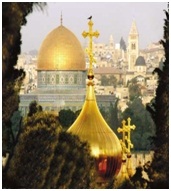
Jerusalem is a religious center sacred to all three monotheistic religions: Judaism,
Christianity, and Islam. Religious pilgrims from all nations continue to congregate
in the Holy City and millions of people flow through the gates of Jerusalem each
year. Jerusalem appears throughout the entire Scriptures. The Scriptural history
of Jerusalem (known then as "Salem"), begins when Abraham meets "Melchizedek" (King
of Justice) about 2000 BC. Through the ages it has been called by many names: Urusalim,
Salem, Mount Moriah, Adonai Urah, Jebus, Jerusalem, Zion, the City of David, Ariel
(Lion of God).God has declared that this is the place He will establish His Name
and will dwell there forever. David conquered Jerusalem by defeating the Jebusites
in 1052 BCE (Chronicles 1 11:4-9). In history, No other city has been beloved and
fought over as Jerusalem. After David's death, Solomon (in 1015 BC/BCE) began to
"build a house for the Name of the Lord" (Chronicles 2 2:1).Israel was divided after
Solomon's death (979 BCE). The kingdom of Israel was in the north, while Judah was
in the south. Jerusalem was the capital of Judah (the Southern Kingdom). It was
ruled by a succession of twenty kings from 979 BCE to 586 BCE. Their reigns lasted
from as short as three months (Jehoahaz and Jehoiachim) to as long as fifty-five
years (Manasseh).
Jerusalem was entirely destroyed by Nebuchadnezzar in 586 BC/BCE. The city and the
Holy Temple were completely demolished and the articles of the Temple and its treasures
were carried off to Babylon. The inhabitants that were not killed were also taken
to Babylon. Jerusalem was to lie desolate for seventy years in order that the land
might enjoy its Sabbaths (Chronicles 2 36:17-21/Leviticus 26:34). Seventy-one years
later (445 BCE) In 539 BCE, Cyrus, king of Persia issued a proclamation to rebuild
the Holy Temple in Jerusalem.
When Christianity became the official religion of the Roman Empire under Constantine,
the basilica of the Holy Sepulchers was built in Jerusalem, the most important and
prominent building in the city at the time. During the Byzantine era (330-640 CE)
many impressive Christian architectural monuments were built in the city. Jerusalem
was a major Christian center, attracting pilgrims from all over the Roman Empire.
For many Christian pilgrims to Jerusalem, the most important and meaningful thing
they will do while in the city is walk the Via Dolorosa, the route that Jesus took
between his condemnation by Pilate and his crucifixion and burial. The Via Dolorosa
pilgrimage is followed by Christians of many denominations, but especially Catholics
and Orthodox. The Via Dolorosa pilgrimage been followed since early Christianity,
beginning as soon as it became safe to do so after Constantine legalized the religion
(mid-4th century). Originally, Byzantine pilgrims followed a similar path to the
one taken today, but did not stop along the way. Over the centuries, the route has
changed several times.
By the 8th century, the route had changed: beginning at the Garden of Gethsemane,
pilgrims headed south to Mount Zion then doubled back around the Temple Mount to
the Holy Sepulchre. The middle Ages saw two rival routes, based on a split in the
Latin Church: those with churches to the west went westward and those with churches
in the east went eastward.
From the 14th to 16th centuries, pilgrims followed the Franciscan route, which began
at the Church of the Holy Sepulchre and included eight stations. Around this time,
the tradition of 14 Stations of the Cross was developing in Europe. To avoid disappointing
European pilgrims, the difference was made up with the addition of six more stations.
Today, the main route of the Via Dolorosa is that of the early Byzantine pilgrims,
with 14 stations along the way. However, alternative routes are followed by those
who have different opinions on the locations of various events. Anglicans believe
Jesus would have been led north towards the Garden Tomb, while Dominican Catholics
start from Herod's Palace near Jaffa Gate
Via Dolorosa
The route of the Via Dolorosa begins near the Lions' Gate in the Muslim Quarter
and ends at the Church of the Holy Sepulchre in the Christian Quarter, covering
500 meters and incorporating 14 Stations of the Cross. Unfortunately, the Via Dolorosa
can prove a difficult place for prayer and contemplation, as it travels through
busy streets lined with snack bars and tourist shops, each of the 14 Stations of
the Cross along the Via Dolorosa is marked with a plaque, but these small signs
can be difficult to spot. Probably the best way to be sure of recognizing all the
stations is to join the Friday procession (see "Festivals & Events" below) or a
guided walk (ask at the Christian Information Centre). Preparation in advance is
helpful, too, and perhaps the following description of the Via Dolorosa can help.
Station 1 is Jesus' condemnation by Pontius Pilate (Mt 27:11-24; Mk 15:1-15;
Lk 23:1-25; John 18:28-19:16). This event is held to have occurred at the site of
Madrasa al-Omariya, 300m west of the Lion's Gate. The madrasa is still used as a
school and can be entered with the permission of the caretaker at specific times
(Mon-Thu, Sat 2:30-6; Fri 2:30-4pm). As mentioned above, an alternative location
for this event is Herod's Palace at Jaffa Gate. Station 2 is where Jesus
took up his cross. This is located next to the Franciscan Monastery of the Flagellation,
across the road from the First Station. The Chapel of Judgment/Condemnation, on
the left, marks the site where Jesus was sentenced to death; the Chapel of the Flagellation,
on the right, is where he was beaten by Roman soldiers (Mt 27:27-30; Mk 15:16-19;
Jn 19:1-3). From here, the Via Dolorosa turns south on Tariq Bab al-Ghawanima and
passes the northwestern gate of the Temple Mount, Bab al-Ghawanima. Up ahead on
the north side of the Via Dolorosa is the Convent of the Sisters of Zion, which
contains large pieces of the Lithostratos (Pavement of Justice). The Lithostratos
stone slab has grooves carved in it, which are variously interpreted as channels
for rainwater or traction for horses. What is clear, though, is that the squares
and triangles on the slabs were made by game-playing Roman soldiers. The floor has
been dated to the time of Hadrian (AD 117-138) and therefore postdates Jesus, but
it is still fascinating and serves to bring to life the Gospel account of soldiers
gambling for Jesus' clothes. Just west of the entrance to the Lithostratos is the
Ecce Homo Arch, where Pilate identified Jesus to the crowd saying "Ecco homo" ("Behold
the man" - Jn 19:5). The arch is part of a gate dating from Emperor Hadrian's time
and was given its present name in the 16th century.Marked by a relief sculpture
above the door of a small Polish chapel at the junction with al-Wad Road. Station
3 is where Jesus fell for the first time under the weight of his cross.
Station 4 is where Mary watched her son go by with the cross, and is commemorated
at the Armenian Church of Our Lady of the Spasm. (Neither of these events is recorded
in the Bible.) Be sure to go inside the church to see the remarkable 5th-century
floor mosaic, which includes an outline of a pair of sandals, said to be Mary's
footprints. At Station 5, Simon of Cyrene was forced by Roman soldiers to help Jesus
carry this cross (Mt 27:32; Mk 15:21; Lk 23:26). This is located on the corner where
the Via Dolorosa turns west off al-Wad Road and begins to narrow as it goes uphill.
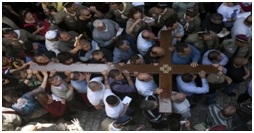
At the top of a steep hill is Station 6, where, according to a tradition dating
from the 14th century, St. Veronica wiped Jesus' face with her handkerchief, leaving
an image of his face imprinted on the cloth. The relic, known as the Sudarium or
Veronica, is kept at St. Peter's Basilica in Rome. Veronica's name may derive from
the Latin vera icon, "true image." Station 6 is commemorated by the Church of the
Holy Face, served by the “Little Sisters,” a Greek Catholic rite. The chapelis part
of the Crusader monastery of St. Cosmos and was refurbished by Barluzzi in 1953.
Inside are refurbished Crusader arches. At Station 7, Jesus fell for a second time.
This is marked by a Franciscan chapel at the Via Dolorosa's junction with Souq Khan
al-Zeit.
Station 8 is across the market street and up the steps of Aqabat al-Khanqah,
opposite the Station VIII Souvenir Bazaar. A cross and the Greek inscription "NIKA"
on the wall of the Greek Orthodox Monastery of St. Charalambos mark the place where
Jesus consoled the lamenting women of Jerusalem (Lk 23:27-31). A rather confusing
route across Souq Khan al-Zeit, south down Khan al-Zeit, and up 28 stone steps leads
to Station 9 at the Coptic Patriarchate next to the Church of the Holy Sepulchre.
Here, a Roman pillar marks the site of Jesus' third fall. Stations 10-14 are all
inside the Church of the Holy Sepulchre. To get to the entrance from Station 9,
head south down Souq Khan al-Zeit to the end, turn right into Souq al-Dabbagha and
go straight on to the doorway at the end of the street. See the Church of the Holy
Sepulchre article, and the interactive floor plan of the church, for details and
photos. Briefly, the last five stations are as follows: Jesus is stripped - top
of the stairs to the right outside the entrance ,Jesus is nailed to the cross -
upstairs just inside the entrance, at the Latin Calvary,Jesus dies on the cross
- Rock of Golgotha in the Greek Orthodox Calvary Jesus is taken down from the cross
- statue of Our Lady of Sorrows next to the Latin Calvary, Jesus is laid in the
tomb - in the edicule on the main floor, inside the tiny Chapel of the Holy Sepulchre.
Ecce Homo Church - Jerusalem

Ecce Homo Church is a Roman Catholic Church on Via Dolorosa in Jerusalem, along
the path that according to tradition Jesus walked, carrying his cross, on the way
to his crucifixion. The church is now part of the Convent of the Sisters of Zion.
The Latin words Ecce Homo (i.e. Behold the Man) is attributed to Pontius Pilate
in the Gospel of John 19:5, when he presented a scourged Jesus Christ, bound and
crowned with thorns, to a hostile crowd. The New Testament also says that Jesus
was dressed in fake royal attire, to mock the claim that he was "King of the Jews."
The church contains one arch of a Roman gateway, which has a further arch crossing
the Via Dolorosa outside. There was originally a third arch to the gateway, on the
other side of the street; in the sixteenth century, it was incorporated into a monastery
for Uzbek dervishes in the Order of the Golden Chain, but this was later demolished,
taking the arch with it. Traditionally, the arch was said to have been part of the
gate of Herod's Antonia Fortress, which itself was alleged to be the location of
Jesus' trial by Pontius Pilate;
The traditional conclusion was that the arch was the location of Pontius Pilate's
Ecce Homo speech, reported by the Bible. However, due to archaeological investigation,
it is now known that the arch is a
triple-arched gateway, built by Hadrian, as an entrance to the eastern Forum of
Aelia Capitolina; the site of the forum was previously a large open-air pool of
water (the Striation Pool).
The Holy Sites of Palm Sunday Road
- Jerusalem
Starting at the top of the Mount of Olives, walking down Palm Sunday Road, and ending
at the Eastern Gate, the path that Jesus took his last days in Israel is a spiritual
journey for many tourists. It was on this road that Jesus road a donkey to the Temple
Mount, and was later to be sacrificed on the Mount of Olives four days later. The
sheer majesty and beauty of the Dome of the Rock and the Old City before you as
you walk is breath taking, begin your walking tour down Palm Sunday Road. The road
is very steep and narrow, continues downward, ending with the Tomb of the Virgin
Mary on your right and the Church of All Nations on your left.
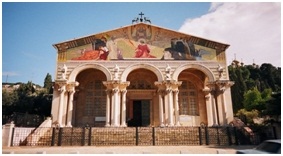
The Church of All Nations - Jerusalem
Officially named the Basilica of the Agony, is located at the foot of the Mount
of Olives in Jerusalem next to the Garden of Gethsemane. The Catholic Church enshrines
a section of stone in the Garden of Gethsemane that is believed to be where Jesus
prayed on the night of his arrest (Matthew 26:36). In the Bible, Then Jesus went
with his disciples to a place called Gethsemane, and he said to them, "Sit here
while I go over there and pray." He took Peter and the two sons of Zebedee along
with him, and he began to be sorrowful and troubled. Then he said to them, "My soul
is overwhelmed with sorrow to the point of death. Stay here and keep watch with
me." Going a little farther, he fell with his face to the ground and prayed, "My
Father, if it is possible, may this cup be taken from me.
Yet not as I will, but as you will." Matthew 26:36-39
The modern church stands on the foundations of two ancient churches: a 4th-century
Byzantine basilica, destroyed by an earthquake in 746 and a 12th-century Crusader
chapel, which was abandoned in 1345. The Basilica of the Agony was built from 1919-24
with funding from 12 different countries, which gave it its nickname: "the Church
of All Nations."
The domed roof, thick pillars, and floor mosaic give the church a Byzantine appearance.
The architect of the building was Antonio Barluzzi, who also designed the nearby
Dominus Flevit Church. The front of the church features a colorful façade supported
by a row of pillars. The mosaic above the entrance depicts Christ as the link between
God and humanity. Inside, the symbols of each country that contributed to the church
are incorporated into the inlaid gold ceilings of each of 12 cupolas. The 12 cupolas
rest on six monolithic pillars. The basilica's three aisles culminate in three apses
at the east end, which are decorated with mosaics depicting biblical events in the
Garden of Gethsemane. In the center, the high altar overlooks a large slab of rock,
which is said to be the very rock on which Jesus prayed in agony on the night of
his betrayal. The Church of All Nations is run by the Franciscans, but an open altar
in the garden is used by the Anglican community on Maundy Thursday (the day before
Good Friday).
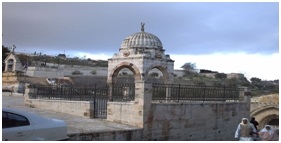
Tomb of the Virgin-Jerusalem
Mary's Tomb is a tomb located in the Kidron Valley, on the foothills of Mount of
Olives, near the Church of All Nations and Gethsemane garden, originally just outside
Jerusalem. It is regarded as the burial place of Mary, the mother of Jesus by most
Eastern Christians (many of whom refer to her as Theotokos), in contradistinction
to the House of the Virgin Mary near Ephesus. The biblical accounts provide no information
about the end of Mary's life or the place of her burial. A number of places have
claimed the honor, including Ephesus in Turkey. Traditions about Mary's burial in
this area of Jerusalem may be as old as the 2nd or 3rd century. Such traditions
became stronger in the 5th century,when the claims of Ephesus were
strongly disputed.
Around 455, an ancient tomb here was isolated by quarrying out the surrounding rock.
The process was similar to that carried out around the tomb of Christ under Emperor
Constantine (see Church of the Holy Sepulchre). The first written mention of a church
on this site dates from the 6th century. A round church was built above the tomb
by Mauritius Tiberius (582-602) but destroyed by the Persians in 614. The church
was rebuilt, and the pilgrim Arculf visited it in 680. He recorded that the church
had two levels, both of which were round. The upper level had four altars; the lower
level had an altar at the east end and the tomb of Mary on the right. A 9th-century
church record says that the site was served by 13 presbyters and clergy, 6 monks,
and 15 nuns.
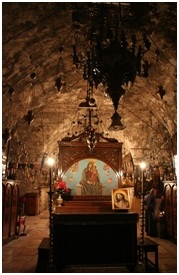
When the Crusaders arrived, all they found were ruins. They rebuilt the church in
1130 and included a Benedictine monastery to make it the "Abbey Church of St. Mary
of Jehosaphat." The monastic complex included early Gothic columns, red-on-green
frescoes, and three towers for protection. Queen Melisande was buried in the lower
church in 1161. When the Crusader kingdom fell in 1187, Salah al-Din destroyed most
of the upper church and used the stone to repair the city walls, but the lower church
remained virtually intact. The site was taken over by Franciscans after the Crusaders
left, and has since been shared by Greeks, Armenians, Syrians, Copts, Abyssinians
and Muslims. The Tomb of the Virgin is venerated by Muslims because, during his
Night Journey from Mecca to Jerusalem, the Prophet Muhammad saw a light over Mary's
tomb. In addition, Caliph Umar prayed at Gethsemane in 638. Steps from the road
descend into a square courtyard containing the upper church, which is little more
than a c.1130 portal and pointed arch supported on eight marble columns.Inside,
seven steps down a wide 12th-century staircase of 47 steps is the tomb of Queen
Melisande, who died in 1161. The tomb was once protected by iron bars; an arch with
a lily-bud motif remains. Opposite her tomb is the vault for the family of her son,
King Baldwin II. The walls of the stairs are 12th century, and include 12th-century
windows blocked up to keep out the Kidron floods. Melisande's body was moved in
the 14th century to a place at the foot of the stairs, and her tomb was subsequently
identified with Mary's parents Joachim and Anne. The tombs of King Baldwin's family
were later identified as the tomb of Joseph. The lower church at the bottom of the
stairs is a Byzantine (5th-century) crypt, partly hewn out of rock and featuring
original Byzantine masonry. The area is dimly lit and the walls are blackened with
centuries of smoke, giving the place an air of great
Antiquity. The room is opulantly decorated with icons and a forest of hanging lanterns.
There is a built apse to the west and a longer rock-cut apse to the east, in which
Mary's tomb is marked by a small square chapel. It is quite similar to her son's
tomb in the Church of the Holy Sepulchre. The altar inside the tomb conceals the
remains of a bench tomb that may date from the 1st century. A niche south of the
tomb is a mihrab indicating the direction of Mecca, installed when Muslims had joint
rights to the church. Altars of the Greeks and Armenians also share the east apse;
an Ethiopian altar and cistern occupies the west apse.
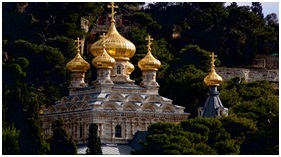
Church of Mary Magdalene- Jerusalem
Bringing a taste of the Kremlin to Jerusalem, the 19th-century Church of Mary Magdalene
is a distinctive Jerusalem landmark on the Mount of Olives. The Church of Mary Magdalene
was built by Tsar Alexander III in 1888 in the traditional Russian style. Easily
spotted from the Temple Mount, the Russian church's seven golden domes have been
newly gilded and sparkle in the sun. Combined with its multiple levels and sculpted
white turrets, the church looks like something out of a fairytale.The church is
worth a close-up visit as well, for it stands in a tranquil garden and is filled
with Orthodox icons and wall paintings inside. The crypt holds the remains of the
Grand Duchess Elizabeth, who was killed in the Russian revolution of 1917.Also buried
here is Princess Alice of Greece, who harbored Jews during the Nazi occupation of
Greece
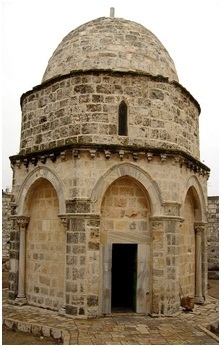
Chapel of the Ascension -Jerusalem
The Chapel of the Ascension in Jerusalem is a Christian and Muslim holy site that
is believed to mark the place where Jesus ascended into heaven. The small round
church/mosque contains a stone imprinted with the very footprints of Jesus.
When he had led them out to the vicinity of Bethany, he lifted up his hands and
blessed them. While he was blessing them, he left them and was taken up into heaven.
Then they worshiped him and returned to Jerusalem with great joy. - Luke 24:50-51
He was taken up before their very eyes, and a cloud hid him from their sight. They
were looking intently up into the sky as he was going, when suddenly two men dressed
in white stood beside them. "Men of Galilee," they said, "why do you stand here
looking into the sky? This same Jesus, who has been taken from you into heaven,
will come back in the same way you have seen him go into heaven." - Acts 1:9-11
Before the conversion of Constantine (312), early Christians honored the Ascension
of Christ in a cave on the Mount of Olives, probably because of concerns for safety.
By the time the pilgrim Egeria visited Jerusalem in 384, the place of the Ascension
was venerated on the present open site, uphill from the cave. The first church was
built here around 390 by Poimenia, a pious Roman lady. The original church was destroyed
in the Persian attack of 614 but restored by Modestus. In 680, the pilgrim Arculf
described the church as a round building open to the sky, with three porticoes entered
from the south. Eight lamps shone brightly at night through windows facing Jerusalem.
Inside was a central edicule containing the footprints of Christ "plainly and clearly
impressed in the dust" inside a railing. Pilgrims were permitted to take some of
the dust home with them! A 9th-century record notes that the church was served by
Three clergy and presbyters, When the Crusaders arrived; they rebuilt the Church
of the Ascension as a roofed octagon (c.1150) and fortified the exterior
In 1198, after the fall of the Crusader kingdom, Salah al-Din gave the church to
two of his followers, who added a stone dome and mihrab. The ascension of Jesus
is recognized in Islam, although it is not mentioned in the Qur'an. The building
remained in use as a mosque for over 300 years. The building fell into ruin by the
end of the 15th century, and the east section of the octagonal surround-wall was
walled off to form the asymmetrical shrine that stands today. A mosque and minaret
were added next to the chapel in 1620 and the entire site remains in Muslim possession.
To the right of the entrance is the small 1620 mosque, Zawiyat al-Adawiyya, from
which there is a good view of the Chapel of the Ascension and the surrounding countryside.
The entrance leads into a courtyard with a paved path leading to the small Chapel
of the Ascension. The main body of the chapel is from the Crusader era; the octagonal
drum and stone dome are Muslim additions. The exterior octagonal walls are decorated
with arches and slim marble columns, which support fine 12th-century capitals. These
feature entwined foliage; two with animal motifs featuring winged quadrapeds with
the heads of birds.Entered from the west, the chapel has a mihrab indicating the
direction of Mecca in the south wall. On the floor, inside an asymmetrically placed
frame, is a slab of stone imprinted with the right footprint of Christ. The section
bearing the left footpring was taken to the Al-Aqsa Mosque in the middle Ages. Hooks
in the wall around the courtyard are used to stretch tents for the celebration of
the Feast of the Ascension, which draws many pilgrims. A small burial crypt next
to the chapel is revered by all three monotheistic religions, but based on different
beliefs about its occupant. Jews believe it contains the 7th-century BC prophet
Huldah, one of seven female prophets mentioned in the Bible (2 Kings 22:14-20);
Christians hold it to be the tomb of the 5th-century saint Pelagia; while Muslims
maintain that the 8th-century holy woman Rabi'a al-Adawiya (for which the mosque
is named) is buried here.
Church of the Holy Sepulcher- Jerusalem
The Church of the Holy Sepulchre is one of the most Holy sites in the Christian
world, the site of the burial place of Jesus. The 12th C structure is located on
the traditional site of Golgotha, the crucifixion and burial site of Jesus.
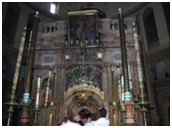
Constantine's Basilica (4th-7thC)
The Church was established in 333 by the Roman emperor Constantine, after his mother,
Queen Helena, marked the place of Golgotha during her visit in 326AD. The site was
selected based on memories of the site as an execution place, and on the existence
of a garden, tombs and fragments of wood planks. The large basilica was leveled
by the Persian intrusion (614AD). The new church was built on top of it, so few
remains of the foundation are left. However, this basilica is illustrated in the
Byzantine mosaic map of Madaba, which was discovered in 1884 in a Byzantine church
in Madaba, Jordan. This ancient map, laid out in the 6th C AD, shows the map of
the Holy Land, with dozens of illustrated sites, including Jerusalem and the original
basilica that once stood there. It has three doors on the front, parts of one of
them survived in the current structure.
Restored Basilica (7th-11th C)
After the conquest of Jerusalem by the Arabs (638AD) the basilica was partially
restored on a smaller scale. It was initially honored by the new rulers, who respected
Jesus and his burial place. However, it was again leveled in 1010AD by the Arab
rulers when their faith became more extreme. This destruction may have sparked the
Crusaders waves of conquest, which aimed at regaining the control of the Holy city
and rebuilding the church.

Crusaders (11-12th C)
In 1099AD the Crusaders take the city and hold it until 1187. They restored the
basilica and inaugurated it in 1149AD as St. Sepulchre. After the surrender and
fall of the city to the Saladin army, the Arabs honored the church, and the key
to the church was kept by Arab families - until this date.The third Crusaders campaign
(1189-1192) attempted to recapture the Holy city and regain control of the church,
but failed. However, a treaty between Richard and Saladin (1192-1195) allowed pilgrims
to visit the church. Five more Crusades (1204-1270) also failed to regain the city.
Modern times
In July 1927 the church suffered damages in the 6.3 magnitude earthquake. The church
is controlled by different Christian denominations within the church, each having
a part of it: Catholics, Armenian, Greek Orthodox, Syrian Orthodox, Coptic and Ethiopian.
The Muslim families have the key to the main door since 1187, and used to sit in
the entrance, manage the church, and mediate between the different denominations.
It is opened to the public and attracts hundreds of thousands of visitors year round.
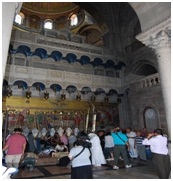
Here, where Orthodox and Catholic Christians mark the crucifixion and burial of
Jesus, Christians of other denominations can explore the world of what scholars
call the “historic churches.” Six denominations celebrate their rites in and around
the cavernous house of worship. These communities are some of Christianity’s most
ancient. Among the lesser known churches in the West, the Ethiopians, for example,
trace their Christian origins back to Philip’s conversion of the Ethiopian eunuch
(Acts 8:26-34), and listening to the Syriac Orthodox praying in Aramaic might be
the only chance you’ll ever have to hear the language Jesus used on a daily basis.
Some Christians prefer to relate to the crucifixion and resurrection at the Garden
Tomb, where a tomb in its garden setting can still be seen. But the Church of the
Holy Sepulchre can be a significant stop in understanding both contemporary Christianity
and its long and complex history. At the Church of the Holy Sepulchre, you’ll need
a flashlight to see the Tomb of Joseph of Aramathea, which is an original Second-Temple
era cave-tomb.The tomb of Jesus, church historians say, was destroyed by the Muslim
Caliph Hakim in 1009. Its surviving portions were covered up by the Edicule, a structure
built in the Rotunda by the Russian Orthodox in the early nineteenth century when
they wielded major influence in the church and the country.
This Church of the Holy Sepulchre is said to be one of the most complex structures
in existence. The first building on this spot was, of all things, a pagan shrine
built in the second century by Emperor Hadrian. To do so, he used stones from the
ruined Temple as painful reminders to both Jews and Christians that the Romans were
in charge of their holy places. When Constantine built the first church here in
the fourth century, he placed it where his mother, Queen Helene, is said to have
found a piece of the cross. That church eventually extended across the equivalent
of a block or two of what is now today’s Old City. Your visit can begin by descending
a flight of stairs whose walls are covered with crosses incised by hundreds of pilgrims
over hundreds of years. Deep below ground level is the Armenian chapel, abutting
a First Temple-period stone quarry where tradition says Queen Helene found the cross.
The centerpiece of the main floor is the Edicule. Its icons and lanterns may be
unfamiliar to some, but visitors often say they feel spiritually uplifted from the
moments spent in the utter silence of the tiny interior room marking the traditional
tomb. Nearby is a stone slab where tradition says the body of Jesus was prepared
for burial, and where you may see pious Orthodox and Catholic Christians praying
fervently. Visitors are moved by the beautiful mosaic behind the stone, which shows
with sadness and hope the moments when Jesus is taken down from the cross and laid
in the tomb. Up a steep flight of stairs, the site of the crucifixion itself is
marked by both a Greek Orthodox and a Catholic altar, where Christians from around
the world stand patiently in line waiting to touch the rock they hold sacred.
Visitors to the Church of the Holy Sepulchre find themselves steeped in the Christian
history as well as experiencing living testimony to the tenacity of Christians to
revere their own piece of Jerusalem from earliest times to the present.
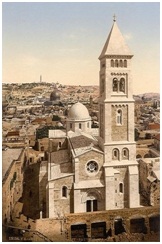
Lutheran Church of the Redeemer- Jerusalem
The austere Lutheran Church of the Redeemer was built in the Christian Quarter of
Jerusalem in 1869. The Church of the Redeemer was commissioned by Prussian Crown
Prince Friedrich Wilhelm, who was given the east half of the Muristan by the Sultan
during a visit to Jerusalem in 1869. The church was built in the northeast corner
of the Muristan over the Church of St. Mary of the Latins, which had been constructed
by the weathy Amalfi merchants c.1050 and had fallen into disrepair. An even earlier
church may have stood here from the 5th century. The old cloisters, refectory, and
original plan of the medieval church are preserved in the new church. The Church
of the Redeemer (Erlöserkirche) was consecrated on October 31, 1898, in the presence
of Emperor William II and the Empress Augusta Victoria (daughter of England's Queen
Victoria). One of the most interesting features of the church is the original sculpture
on the medieval northern gate, which was the principal Benedictine entrance of St.
Mary of the Latins. The door is decorated with the signs of the Zodiac and well-worn
symbols of the months.The symbol of January is at the bottom left and at the top
center are a sun (a half-figure with a disc above his head) and moon (a female with
a crescent) beween June and July. August, a thresher, is in the best shape; October
is a man with a cask. The lively figures are reminiscent of the sculptures on the
facade of the neighboring Church of the Holy Sepulchre. The modern entrance to the
neo-Romanesque church is on the west from Frederick William Street. The church houses
four Lutheran congregations speaking four different languages: Arabic, German, English,
and Danish.
The 12th-century cloisters, with two tiers of galleries, and refectory are on the
south side of the church and entered from the same street. You can climb 177 steps
up the bell tower, the tallest in the vicinity, for a fine view over the Church
of the Holy Sepulchre and as far as the Mount of Olives and Mount Zion. Said to
be built over the home of John the Baptist's parents, the Church of the Visitation
stands high up on the hillside of Ein Kerem in Jerusalem. From here there is a wonderful
view of the valley and the surrounding wooded hills.
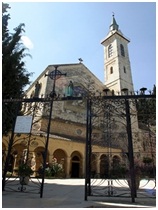
Church of the Visitation- Jerusalem
In the Bible, In Luke 1, the pregnant Mary visited her pregnant cousin Elizabeth
and stayed for three months (Lk 1:56). Upon Mary's arrival, the unborn John the
Baptist recognized the unborn Jesus and "leaped with joy" in Elizabeth's womb (Lk
1:44). Elizabeth exclaimed, "Blessed is she who has believed that what the Lord
has said to her will be accomplished!" and Mary sang a hymn of thanksgiving known
as the
Magnificat: "My soul glorifies the Lord and my spirit rejoices in
God my Savior, for he has been mindful of the humble state of his servant. From
now on all generations will call me blessed, for the Mighty One has done great things
for me - holy is his name. His mercy extends to those who fear him, from generation
to generation.
He has performed mighty deeds with his arm; he has scattered those who are proud
in their inmost thoughts. He has brought down rulers from their thrones but has
lifted up the humble. He has filled the hungry with good things but has sent the
rich away empty. He has helped his servant Israel, remembering to be merciful to
Abraham and his descendants forever, even as he said to our fathers." (Luke 1:46-55)
This event is the "Visitation" commemorated by the present church, which is believed
to stand over the site where the event took place. The present Church of the Visitation
incorporates a natural
grotto that once contained a small spring. The grotto
became a place of worship in the Byzantine period, and the Crusaders
built a large, two-storey church over it. The church collapsed after the Crusaders
left. In 1679, the site was bought by the
Franciscans. After two centuries,
they finally managed to get permission from the Ottoman authorities to restore the
church. The Lower Church was restored in 1862 and the Upper Church was completed
in 1955.
Ein Kerem is a quiet village 7km southwest of the Old City. Formerly Palestinian,
the village's stone houses are now filled primarily with Jewish artists and sculptors.
The area has several galleries and a number of good restaurants. The Church of the
Visitation is reached by steps up from the main road through the village. In the
church courtyard, one wall is covered with ceramic tiles bearing the words of the
Magnificat in 42 languages. Designed by Antonio Barluzzi, the
upper church
has a Tuscan-style painted ceiling and large murals depicting the titles with which
Mary has been endowed — Mother of God, Refuge of Sinners, Dispenser of All Grace,
Help of Christians — and the Immaculate Conception. The
lower church is decorated
with large frescoes of other Hebrew women of the Bible known for their "hymns and
canticles." Down the hill from church, a small mosque marks the site of the
Spring
of the Virgin, for which Ein Kerem ("spring of the vineyard") is named.
Nowadays, the spring is used to irrigate crops
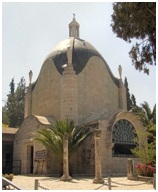
Church of Dominus Flevit - Jerusalem
Dominus Flevit is a Roman Catholic Church located on the Mount of Olives
immediately facing the Old City of Jerusalem. Dominus Flevit, which translates from
Latin as "The Lord Wept", was fashioned in the shape of a teardrop to symbolize
the tears of Christ. Here, according to the 19th chapter of the Gospel of Luke,
Jesus, while walking toward the city of Jerusalem, becomes overwhelmed by the beauty
of the Second Temple and predicting its future destruction, and the diasporas of
the Jewish people, weeps openly. (Luke 19:37-42) This small church is located half-way
down the Mount of Olives, on the traditional route of Jesus’ Palm Sunday procession.
The church was built in 1955 on the ruins of a previous, Byzantine, church and traditionally
recalls the place where Jesus wept over the City of Jerusalem. There are some fine
mosaics to view and the orientation of the church has been reversed so that the
congregation can look through a beautiful window behind the altar to see the city
beyond. There is a large balcony outside the church where groups can stand to take
in the magnificent views of the Old City; this is best done in the morning with
the sun behind you. Here provides a wonderful opportunity to see the distances involved
in the last days of Jesus before his crucifixion and to put the gospels into a geographical
context.
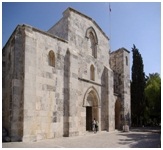
Church of St Anne- Jerusalem
The
Church of St. Anne is a beautiful 12th-century Crusader church, erected
over the traditional site of the birthplace of Anne (Hannah), the mother of Mary.
It is an excellent example of Romanesque architecture. St. Anne's Church was built
between 1131 and 1138 to replace a previous Byzantine church. Shortly after its
construction, it was enlarged by moving the facade forward by several meters. In
1192, Saladin turned the church into a
Muslim theological school, Which is
commemorated in an inscription above the church's entrance, eventually abandoned,
the church fell into ruin until the Ottomans donated it to France in 1856. It was
subsequently restored, but most of what remains today is original. The church is
right next to the
Bethesda Pool, believed to be the site where Jesus healed
a paralytic (John 5:1-15). Here you can see ruins
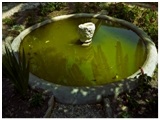
of a Roman temple to the god of medicine and remains of a Byzantine church
built over the temple. As the church is just a few hundred feet east of the Sanctuaries
of the Flagellation and the Condemnation, at the beginning of the Via Dolorosa,
you Might want to visit it before following the Stations of the Cross, Saint Anne's
acoustics, designed for Gregorian chant, are so perfect that the church is virtually
a musical instrument to be played by the human voice. Pilgrim groups come to sing
in the church throughout the day, and you, too, are welcome to prepare a song of
any religion--only religious songs are permitted. The church's acoustics are most
amazing when used by a soprano or a tenor solo voice. St. Anne's Church is
located in the Muslim Quarter, near the Lion's Gate. Enter through a wooden doorway
leading to a hidden garden enclave.
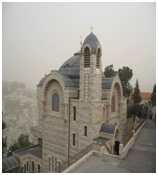
Church of St Peter in Gallicantu- Jerusalem
The
Church of Saint Peter in Gallicantu is a Roman Catholic Church located
on the eastern slope of Mount Zion, just outside the Old (walled) City of Jerusalem.
The fabulous Saint-Peter-in-Gallicantu Church was built in 1931. According to tradition,
this was the place of the palace of high priest Caiaphas, where Jesus was brought
to jail after his arrest. Its name (Gallicantu, means the cock's crow) is given
after the story of Peter's triple denial of Christ and the cock crowing twice. A
Byzantine church was built in 457AD. It was destroyed in 1010, and rebuilt by the
Crusaders in 1102 (who renamed it to the present name). The church was in ruins
again in 1320, and rebuilt in 1931.
The church overlooks East Jerusalem and on a clear day the Separation Wall can be
seen in the distance. The church commemorates the Peter’s triple denial of Christ
(and his repentance) in Matthew 26. Christ prophesied that Peter would deny him
three times before “the cock crows.” Galli-cantu in latin means “cockcrow” and its
imagery can been seen everywhere.
The church is versatile. It is built on four levels, the first being the upper church,
a normal (traditional) worship hall , The middle church is built around the ruins
of a Byzantine basilica which is believed to mark the site of Caiaphas’s house,
the high priest, and where Peter denied Christ. One floor lower is the guardroom,
which 0versees (through a peephole) the dungeon, which is believed to be the cell
where Christ spent his last night. Outside the church are more excavations and a
courtyard with a sculpture depicting of the denial.
Mount Zion- Jerusalem
Mount Zion is a site in Jerusalem, the location of which appears to have shifted
several times in history. According to the Hebrew Bible's Book of Samuel, it was
the site of the Jebusite fortress called the "stronghold of Zion" that was conquered
by King David, becoming his palace and the City of David. On the eastern hill of
two hills extending south of the Old City of Jerusalem, archaeological excavations
by Yigal Shiloh uncovered an Iron Age building identified as the remains of "fortress
Zion", thus indicating this to be the original location of Mount Zion.
Sometime during the biblical period after the construction of King Solomon's Temple,
Mount Zion was the term used to refer to the Temple Mount, as according to the Book
of Isaiah (60:14), the Book of Psalms, and the first book of the Maccabees (c. 2nd
century BC). Just before the Roman conquest of Jerusalem after the destruction of
the Second Temple, its location shifted once again: Josephus located the Jebusite
town on the lower eastern hill, but used Mount Zion to refer to the higher hill
across the valley to the west, seemingly a more suitable site for David's palace.
Thus, the western hill extending south of the Old City came to be known as Mount
Zion, and this has been the case ever since.
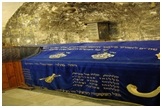
David's Tomb- Jerusalem
King David's Tomb is a site traditionally viewed as the burial place of David, King
of Israel. It is located on Mount Zion in Jerusalem, near the Hagia Maria Sion Abbey.
The tomb is situated in a ground floor corner of the remains of the former Hagia
Zion, a Byzantine church; the upper floor of the same building has traditionally
been viewed as the Cenacle of Jesus. The building is now part of the Diaspora Yeshiva.
ancient house of worship; the upper floor of the same building has traditionally
been viewed as the Cenacle of Jesus.
The tomb is located in a corner of a room situated on the ground floor remains of
the former Hagia Zion a
In 1335, the ancient synagogue and church became a Franciscan monastery, but, due
to tensions with the Greek Orthodox Patriarch, the monastery was closed in 1551
and ownership of the site was transferred to a Muslim family. The site was apparently
not viewed as David's Tomb until the 12th century. According to Benjamin of Tudela,
writing about 1173, the tomb was discovered during repairs to the church; the motivation
for it being declared to be the tomb of David is uncertain. It is impossible to
verify whether the tomb is original to the location, as crusaders removed the tomb
from its earlier context, and placed within it a stone sarcophagus, newly built
for the purpose; the sarcophagus now rests over a 14th century floor.After the 1948
Arab–Israeli War, it fell on the Israel side of the Green Line. Between 1948 and
1967 the Old City was occupied by Jordan, which barred entry to Jews even for the
purpose of praying at Jewish holy sites. The closest accessible site to the site
of the ancient Jewish Temple was Mount Zion. Jewish pilgrims from around the country
and the world went to David's Tomb and climbed to the rooftop to pray. Since 1949,
a blue cloth, with basic modernist ornamentation, has been placed over the sarcophagus.
The images on the cloth include several crown-shaped Rimmon placed over Torah scrolls,
and a violin, and the cloth also features several pieces of text written in Hebrew.
The building is now part of the Diaspora yeshiva.

Upper Room - Jerusalem
The Cenacle, also known as the "Upper Room", is the site of The Last Supper. The
word is a derivative of the Latin word cena, which means dinner. In Christian tradition,
based on Acts 1:13, the "Upper Room" was not only the site of the Last Supper (i.e.
the Cenacle), but the usual place where the Apostles stayed in Jerusalem, and according
to the Catholic Encyclopedia "the first Christian church". Thus the Cenacle is considered
the site where many other events described in the New Testament took place, such
as:
- the Washing of the Feet
- some resurrection appearances of Jesus
- the gathering of the disciples after the Ascension of Jesus
- the election of Saint Matthias as apostle
- the descent of the Holy Spirit upon the disciples on the day of Pentecost
Since at least the fourth century CE a structure identified as the Cenacle, the
site of the Last Supper has been a popular Christian pilgrimage site on Mount Zion
in Jerusalem. It is documented in the narratives of many early pilgrims such as
Egeria, who visited it in 384. The building has experienced numerous cycles of destruction
and reconstruction, culminating in the Gothic structure which stands today.While
the term “Cenacle” refers only to the “Upper Room,” the site is connected to other
points of interest, including a large cenotaph in the lower level, said first by
12th century Crusaders to be the tomb of King David. However, most scholars consider
this attribution to be incorrect; 1 Kings 2:10 says that David was buried “in the
City of David,” an area of Jerusalem geographically disparate from Mount Sion. The
Cenacle is also connected to the Church of the Dormition.
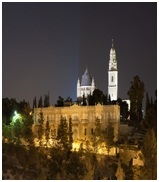
Dormition Abbey- Jerusalem
The conical dome and tall tower of this monastery forms one of Jerusalem’s landmarks;
built on part of a Byzantine church which carried the name ‘Holy Sion, Mother of
all the Churches’. Mary’s death and assumption into heaven was associated with this
place from the 6th century. The existing church Abbey of the Dormition is a German
Benedictine church completed in 1910. It was built on land given by the Turkish
sultan to the German Kaiser Wilhelm II In the courtyard the remains of a mosaic
floor from the Byzantine basilica that once stood here are displayed under a glass
cover. Unfortunately, the glare off the glass makes the mosaic nearly impossible
to see. The abbey's tall tower culminates in a balcony and dome with clock. The
echoing main church is round and uncluttered, conveying a strong sense of lightness
and space. It is far from plain, however: the floor, walls and dome are all decorated
with mosaics, mainly depicting the prophets and apostles. The apse features a lovely
golden Byzantine-style mosaic of the Madonna and Child (from 1939) above the main
altar. The six round chapels are decorated in gold. The lower-level crypt is the
traditional site of Mary's home and death.
A circular pillared hall with ambulatories, it centers on the Chapel of the Dormition
with a carved-stone figure of Mary in repose (dormitio). Above, a mosaic in the
dome depicts Christ receiving her soul. Among the adjacent little chapels is one
donated by the Ivory Coast, with wooden figures and motifs inlaid with ivory. Facilities
on the premises include a bookstore with maps and religious literature and a cafeteria
serving light refreshments.
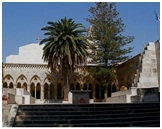
Church of the Pater Noster - Jerusalem
Named for the "Our Father" prayer (Latin: Pater Noster), the Church of the Pater
Noster stands on the traditional site in Jerusalem where Jesus taught his disciples
the Lord's Prayer. Emperor Constantine built a church over a cave here in 4th century,
and this has been partially reconstructed. Plaques in the cloister bear the Lord's
Prayer in 62 different languages. In the Bible, One day Jesus was praying in a certain
place. When he finished, one of his disciples said to him, "Lord, teach us to pray,
just as John taught his disciples." He said to them, "When you pray, say: 'Our Father,
hallowed be your name, your kingdom come. Give us each day our daily bread. Forgive
us our sins, for we also forgive everyone who sins against us. And lead us not into
temptation.'" - Luke 11:1-4
The Gospel account provides almost no information on the location of Jesus' teaching
of the Lord's Prayer, also known as the "Our Father." The 3rd-century Acts of John
(ch. 97) mentions the existence of a cave on the Mount of Olives associated with
the teaching of Jesus, but not specifically the Lord's Prayer. The church historian
Eusebius (260-340) recorded that Constantine built a church over a cave on the Mount
of Olives that had been linked with the Ascension. (Other Constantinian churches
built over a cave are the Church of the Holy Sepulchre and the Church of the Nativity
in Bethlehem.) The church was built under the direction of Constantine's mother
St. Helen in the early 4th century and was seen by the Bordeaux pilgrim in 333.
The pilgrim Egeria (384) was the first to refer to this church as Eleona, meaning
"of olives." When the site for the veneration of Christ's ascension had been moved
up the hill (see Chapel of the Ascension), this cave became exclusively associated
with Jesus' teachings on the conflict between good and evil (Matt 24:1-26:2). Here
Egeria heard this Gospel passage read on Tuesday of Holy Week. Like many buildings
in Jerusalem, the Constantinian church suffered destruction by the Persians in 614.
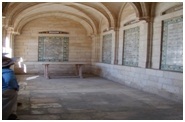
The memory of Jesus' teaching remained associated with this site, but the content
of that teaching shifted from good and evil to the Our Father prayer. This new identification
was based on a clever harmonization of Luke 10:38-11:4 with Mark 11:12-25 (the withered
fig tree). When the Crusaders arrived, the site was associated specifically with
the Lord's Prayer. They constructed a small oratory amidst the ruins in 1106, and
a church was rebuilt in 1152 thanks to the funds of the Bishop of Denmark, who was
buried in it with his butler. 12th-century pilgrims mention seeing marble plaques
with the Lord's Prayer inscribed in Hebrew and Greek at the church. Excavations
have uncovered an inscribed Latin version. The Crusader-era church was damaged in
1187 and destroyed by 1345.In 1851 the remaining Stones of the 4th-century church
were being sold to Jews for
tombstones in the Valley of Jehoshaphat. The site was finally rescued by the Princesse
de la Tour d'Auvergne, who bought the land and began a search for the cave. In 1868
she built a cloister modeled on the Campo Santo at Pisa and founded a Carmelite
convent to the east in 1872. In 1910, the Byzantine foundations over the cave were
found partly beneath the cloister. The cloister was moved and the Byzantine church
began to be reconstructed in 1915. The project is still unfinished.
The 4th-century Byzantine church has been partially reconstructed and provides a
good sense of what the original was like. The half-restored church has the same
dimensions as the original; the garden outside the three doors outlines the atrium
area. The unroofed church has steps leading down into the cave, which was partially
collapsed when discovered in 1910. It is an interesting medley of ancient rock cuttings,
concrete supports and marble furnishings. The cave cuts partly into a 1st-century
tomb. Left of the church's south door is an area paved with mosaics and identified
as a baptistery. The 19th-century cloister is in a European style and upholds the
tradition of multilingual plaques bearing the Lord's Prayer - 62 tiled panels display
the prayer in 62 different languages, from Aramaic to Japanese to Scots Gaelic.
The tomb of the Princesse de la Tour d'Auvergne is on the south side of the cloister.
The lane to the right of the convent's entrance leads to the Russian Church of the
Ascension, established 1887. Its white tower can be seen from the Old City on a
clear day. Byzantine tomb chapels with some lovely Armenian mosaics are preserved
in the small museum
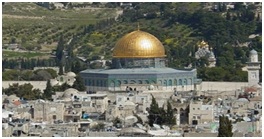
Dome of the Rock - Jerusalem
The most famous Islamic site in Jerusalem is the Dome of the Rock (Qubbat as-Sakhrah).
An impressive and beautiful edifice, the Dome of the Rock can be seen from all over
Jerusalem. It is the crowning glory of the Haram es-Sharif ("Noble Sanctuary"),
or Temple Mount. The Dome of the Rock is not a mosque, but a Muslim shrine. It is
built over a sacred stone. This stone is believed to be the place from which the
Prophet Muhammad ascended into heaven during his Night Journey to heaven. The Dome
of the Rock is the oldest Islamic monument that stands today and certainly one of
most beautiful. It also boasts the oldest surviving mihrab (niche indicating the
direction of Mecca) in the world the
The sacred rock over which the Dome of the Rock is built was considered holy before
the arrival of Islam. Jews believed, and still believe, the rock to be the very
place where Abraham prepared to sacrifice Isaac . In addition, the Dome of the Rock
(or the adjacent Dome of the Chain) is believed by many to stand directly over the
site of the Holy of Holies of both Solomon's Temple and Herod's Temple.
The Dome of the Rock was built by the Umayyad caliph Abd al-Malik from 688 to 691
AD. It was not intended to be a mosque, but a shrine for pilgrims. According to
tradition, the Dome of the Rock was built to commemorate Muhammad's ascension into
heaven after his night journey to Jerusalem (Qur'an 17). But there seems to have
been more to it than this, since the Dome of the Ascension was later built nearby.
Actually, according to the Oxford Archaeological Guide to the Holy Land, "Abd al-Malik's
purpose was more complex and subtle." He wished to erect a beautiful Muslim building
that could compete with the majestic churches of Christendom and would be a symbolic
statement to both Jews and Christians of the superiority of the new faith of Islam.
"His building spoke to Jews by its location, to Christians by its interior decoration.
In the 10th century, the Jerusalem visitor Mukaddasi wrote of the magnificent structure:
At dawn, when the light of the sun first strikes the dome and the drum catches the
rays, then is this edifice a marvellous sight to behold, and one such than in all
of Islam I have not seen the equal; neither have I heard tell of anything built
in pagan times that could rival in grace this Dome of the Rock.
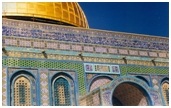
By the 11th century, several legends had developed concerning the Dome of the Rock
and its sacred stone, including the following: They say that on the night of his
Ascension into Heaven the Prophet, peace and blessing be upon him, prayed first
at the Dome of the Rock, laying his hand upon the Rock. As he went out, the Rock,
to do him honor, rose up, but he laid his hand on it to keep it in its place and
firmly fixed it there. But by reason of this rising up, it is even to this present
day partly detached from the ground beneath. In the middle Ages, Christians and
Muslims both believed the dome to be the biblical Temple of Solomon. The Knights
Templar made their headquarters there during the Crusades and later patterned their
churches after its design.
The exterior mosaics that once adorned the Dome of the Rock suffered from exposure
to Jerusalem winters. They were repaired in the Mamluk period, and then completely
replaced with tiles by Sulieman the Magnificent in 1545. At the same time, he created
the parapet wall with its intricate inscription by filling up the thirteen small
arches that originally topped each facade. The windows of the Dome of the Rock date
from this period as well. The tiling was completely replaced in the last major restoration
in 1956-62

Emmaus (‘Am ‘was ) – Near Jerusalem
Emmaus is the village in which Jesus first appeared after the Resurrection.
It is described as being not far from Jerusalem, but its identification with any
particular location is not certain. This particular village, which was the ancient
city of
Nikopolis, was identified as the biblical Emmaus since the fourth
century or earlier, and it became an important pilgrimage destination throughout
the Byzantine era and middle Ages. However, modern scholars think this site is highly
unlikely to be the biblical Emmaus, mainly because it is too far from Jerusalem.
Today
Emmaus Nikopolis is a Muslim village with excavated ruins of a Byzantine
basilica with Crusader renovations, a small archaeological museum, and a modern
Trappist monastery. In the Bible, Emmaus is first mentioned in 1 Maccabees, which
is part of the Catholic Bible, in reference to Judas Machabeus' victory of Gorgias
there in 166-165 BC:
"So they went forth with all their power, and came, and pitched near Emmaus, in
the plain country." (1 Maccabees 3:40).
In the New Testament, it was on the road to Emmaus that two disciples met Jesus
in his first appearance after the Resurrection. Arriving in Emmaus, they broke bread
with him before realizing his true identity: "Now that same day two of them were
going to a village called Emmaus, about 60 stadia (7 miles) from Jerusalem. They
were talking with each other about everything that had happened. As they talked
and discussed these things with each other, Jesus himself came up and walked along
with them; but they were kept from recognizing him.... As they approached the village
to which they were going, Jesus acted as if he were going farther. But they urged
him strongly, "Stay with us, for it is nearly evening; the day is almost over."
So he went in to stay with them. When he was at the table with them, he took bread,
gave thanks, broke it and began to give it to them. Then their eyes were opened
and they recognized him, and he disappeared from their sight. They asked each other,
"Were not our hearts burning within us while he talked with us on the road and opened
the Scriptures to us?" (Luke 24:13-16, 28-32)
The identification of this site as the Emmaus of the gospel story is quite old.
It was well-established by the 4th century and may even date back to the
3rd century
in the writings of Julius Africanus and Origen. Christian pilgrims from the Byzantine
to Crusader eras revered this as the site of Christ's post-Resurrection appearance.
However, according to modern scholars it is
very unlikely that Nikopolis
is the Emmaus where Jesus appeared.
The most and best manuscripts of Luke 24:13 say Emmaus was
60 stadia (7 miles)
from Jerusalem, not 160 stadia as early biblical commentaries say. It is thought
that the number 160 is a correction by Origen and others to make the Gospel text
agree with the Palestinian tradition of their time. Emmaus Nikopolis is 176 stadia
(18 miles) from Jerusalem. Another problem is that the distance of 160 stadia (or
the actual 176) would imply about six hours' walk, but the biblical account says
the disciples had only gone out to the country and could return to Jerusalem before
the gates were shut (Mark 16:12; Luke 24:33). Finally, the Emmaus of the Gospel
is said to be a village, while Nikopolis was described as the flourishing capital
of a "toparchy." The Ammaus mentioned by Josephus (Ant. Jud., VII, vi, 6) as 60
stadia from Jerusalem, where Vespasian and Titus stationed 800 veterans, is probably
the Emmaus of the Bible. But it must have been destroyed at the time of the revolt
of Bar-Cochba (132-35 AD) under Hadrian, and its site was unknown as early as the
third century. Early Christian writers identified the biblical Emmaus with Emmaus
Nikopolis, as it was the only Emmaus known at their time. Other sites closer to
Jerusalem that have been suggested as Emmaus include Abu-Gosh, Kubeibah, and Motsa.
A little after the victory of the Maccabees mentioned above, the Syrian general
Bacchides fortified and garrisoned Emmaus (Josephus, Ant. Jud. 13.1.3). In 4 AD,
during the rebellion of Athrongius against the Romans, the inhabitants of Emmaus
left their city, but it was nevertheless destroyed by Varus (Josephus, Ant. Jud.
17.10.7-9). The city recovered soon after, though, and Josephus (Bel. Jud. 3.3.5)
and Pliny (Hist. nat., 5.14) rank it amongst the "toparchies" of the country. Emperor
Vespasian took Emmaus at the beginning of his campaign against the Jews, stationed
a legion in the neighbourhood, and named it Nikopolis (according to Sozomon, Hist.
eccl. 5.21). According to Eusebius and St. Jerome, the city was named Nikopolis
in 223 by Julius Africanus, its governor and most illustrious son. The pagan emperor
Julian the Apostate closed a
sacred spring at Emmaus Nikopolis in which Christ
was said to have washed his feet and which was believed to have healing properties
(Sozomon, Hist. eccl., 5.21). The city had a bishop, who was subject to the
Bishop of Jerusalem, throughout the Byzantine era.
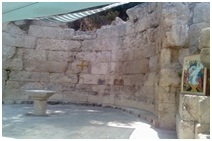
At the beginning of the Arab conquest the plague broke out in Emmaus and the inhabitants
fled. But they must have soon returned, for Emmaus remained a very important town.
It was the last station captured by the
Crusaders on their way to Jerusalem
on June 6, 1099. In the later Middle Ages Emmaus seems to have had some Latin bishops.
The ancient site was
excavated between 1924 and 1930, but much remains to
be uncovered. Today, Emmaus Nikopolis is known as
'Am'was and is a Muslim
village.
Emmaus Nikopolis is home to a 4th or 5th century
Byzantine basilica that
was substantially rebuilt by the
Crusaders. Its apse and walls remain standing
and there is a simple stone altar in the apse. One artifact can be seen at the church,
which is a replica of an interesting
Byzantine inscription found here. It
reads, "In the name of the Father, the Son and the Holy Spirit. Beautiful, the city
of the Christians is.
" Also at the site is a small museum that displays Jewish ossuaries and ancient
mosaics. More remains of the ancient city of Emmaus can be seen in Ayalon Park,
a few hundred meters past the entrance. Just south of the highway from the Emmaus
site is the Latrun Monastery (a.k.a. El-Atroun), founded by the Trappists
in 1890. The Trappists are a strict sect of Cistercian monks, who keep silent most
of the time. The priory is thus also known as the Monastery of Silence
Bethlehem (Birthplace of Jesus Christ)
Perched on a hill at the edge of the Judean desert just 5 miles south of Jerusalem,
Bethlehem is the childhood home of the biblical King David. It is also the birthplace
of Jesus Christ and has been a major site of Christian pilgrimage since the construction
of the Church of the Nativity in the 4th century AD. The town has been a monastic
center for almost as long. In the 5th century AD, St. Jerome built a monastery here
and with the aid of local rabbis translated the Old Testament into Latin from the
original Hebrew for the Vulgate, the standard Latin translation of the Bible used
by the Roman Catholic Church. Bethlehem flourished until Crusader times, but the
following centuries witnessed a great reduction in population, reversed only after
the 1948 war with the arrival of thousands of Palestinian refugees. Since 1995,
Bethlehem has been under the control of the Palestinian National Authority, which
has initiated a program of economic recovery and tourism.
Despite the huge number of pilgrims and chaotic urban growth, Bethlehem retains
an authentic atmosphere, especially in the central area around Manger Square and
in the souk just to the west. The souvenir shops are filled with kitsch religious
objects but also carved olive-wood crib scenes that local craftsmen have produced
for centuries. No visitor should miss the ancient Church of the Nativity on Manger
Square, and the town's other main sights also deserve a visit.
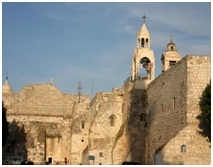
The Church of the Nativity - Bethlehem
The birth of Jesus is narrated in the Gospels of Matthew and Luke. Matthew gives
the impression that Mary and Joseph were from Bethlehem and later moved to Nazareth
because of Herod's decree, while Luke indicates that Mary and Joseph were from Nazareth,
and Jesus was born in Bethlehem while they were in town for a special census. Scholars
tend to see these two stories as irreconcilable and believe Matthew to be more reliable
because of historical problems with Luke's version. But both accounts agree that
Jesus was born in Bethlehem and raised in Nazareth. According to Luke 2:7 (in the
traditional translation), Mary "laid him in a manger because there was no room for
them in the inn." But the Greek can also be rendered, "she laid him in a manger
because they had no space in the room" — we should perhaps imagine Jesus being born
quiet back room of an overflowing one-room house. The gospel accounts don't mention
a cave, but less than a century later, in a both Justin Martyr and the Protoevangelium
of James sayJesus was
born in a cave. This is reasonable, as many houses in the area are still built in
front of a cave.
The cave part would have been used for stabling and storage - thus the manger. The
first evidence of a cave in Bethlehem being venerated as Christ's birthplace is
in the writings of Justin Martyr around 160 AD. The tradition is also attested by
Origen and Eusebius in the 3rd century. In 326, Constantine and his mother St. Helena
commisioned a church to be built over the cave. This first church, dedicated on
May 31, 339, had an octagonal floor plan and was placed directly above the cave.
In the center, a 4-meter-wide hole surrounded by a railing provided a view of the
cave. Portions of the floor mosaic survive from this period. St. Jerome lived and
worked in Bethlehem from 384 AD, and he was buried in a cave beneath the Church
of the Nativity. The Constantine church was destroyed by Justinian in 530 AD, who
built the much larger church that remains today.
The Persians spared it during their invasion in 614 AD because, according to legend,
they were impressed by a representation of the Magi — fellow Persians — that decorated
the building. This was quoted at a 9th-century synod in Jerusalem to show the utility
of religious images. Muslims prevented the application of Hakim's decree (1009)
ordering the destruction of Christian monuments because, since the time of Omar
(639), they had been permitted to use the south transept for worship. The Crusaders
took Jerusalem on 6 June 1009. Baldwin I and II were crowned there, and in an impressive
display of tolerance the Franks and Byzantines cooperated in fully
redecorating the interior (1165-69). A Greek inscription in the north transept records
this event. The Church of the Nativity was much neglected in the Mamluk and Ottoman
periods, but not destroyed. Much of the church's marble was looted by the Ottomans
and now adorns the Temple Mount in Jerusalem. An earthquake in 1834 and a fire in
1869 destroyed the furnishings of the cave, but the church again survived. In 1847,
the theft of the Silver Star marking the exact site of the Nativity was an ostensible
factor in the international crisis over the Holy Places that ultimately led to the
Crimean War (1854–56). In 1852, shared custody of the church was granted to the
Roman Catholic, Armenian and Greek Orthodox churches. The Greeks care for the Grotto
of the Nativity
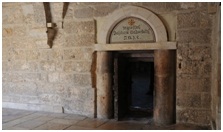
The Door of Humility, a small rectangular entrance to the church, was created in
Ottoman times to prevent carts being driven in by looters, and to force even the
most important visitor to dismount from his horse as he entered the holy place.
The doorway was reduced from an earlier Crusader doorway, the pointed arch of which
can still be seen above the current door. The outline of the Justinian square entrance
can also be seen above the door. The wide nave survives intact from Justinian's
time, although the roof is 15th-century with 19th-century restorations. Thirty of
the nave's 44 columns carry Crusader paintings of saints and the Virgin and Child,
although age and lighting conditions make them hard to see. The columns are made
of pink, polished limestone, most of them dating from the original 4th-century Constantinian
basilica.
Fragments of high-quality wall mosaics dating from the 1160s decorate both sides
of the nave. Each side once had three registers, of which we know the details because
of a description made in 1628. The lowest depicted the ancestors of Jesus; the middle
contained the decrees of provincial and ecumenical councils; and the top has a series
of angels between the windows. The name of the artist, Basilius Pictor, appears
at the foot of the third angel from the right on the north wall. Trap doors in the
present floor reveal sections of floor mosaics surviving from the original basilica.
The mosaics feature complex geometric designs with birds, flowers and vine patterns,
making a rich and elaborate carpet for Constantine's church. Similar doors in the
north transept protect another 4th-century mosaic that shows the Constantinian apse
was octagonal; these are sometimes opened on request. An octagonal baptismal font
in the south aisle dates from the 6th-century church of Justinian; it originally
stood near the high altar. The inscription reads, "For remembrance, rest and remission
of sins of those whose names the Lord knows."
Archaeologists have discovered an octagonal bed of exactly the same dimensions over
a cistern near the altar which provided the required water. After the font was moved
in the Crusader renovation, it became the focus of various colorful legends: it
was the well into which the star of the Magi fell; the well where the Magi watered
their horses; or the well to which David's three heroes came. The main altar at
the east end and the one on the south (Altar of the Circumcision) are the property
of the Greek Orthodox Church.

The main altar includes an Orthodox iconostasis, which is crowned with gilded angels,
icons, gilded chandeliers and lamps. On the north side of the high altar is the
Armenian Altar of the Three Kings, dedicated to the Magi who tied up their horses
nearby, and in the north apse is an Armenian altar dedicated to the Virgin Mary.
The Grotto of the Nativity, a rectangular cavern beneath the church, is the Church
of the Nativity's focal point. Entered by a flight of steps by the church altar,
this is the cave that has been honored as the site of Christ's birth since at least
the 2nd century. A silver star in the floor marks the very spot where Christ is
believed to have been born. The star's Latin inscription reads, "Here of the Virgin
Mary Jesus Christ was born — 1717." The floor is paved in marble, and 15 lamps hang
above the star (six belong to the Greeks, five to the Armenians and four to the
Latins).
All other furnishings date from after the fire of 1869, except for the bronze gates
at the north and south entrances to the Grotto, which are from Justinian's 6th-century
church. A step away from the birthplace shrine is the Chapel of the Manger, owned
by the Roman Catholics. Fragments of 12th-century wall mosaics and capitals around
the manger survive. Back in the upper church, a door in the north apse leads to
the Catholic Church of St. Catherine.
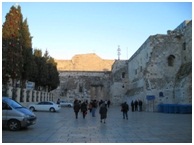
Manger Square- Bethlehem
Manger Square is an important city square in the center of Bethlehem. It takes its
name from the manger where Jesus is said to have been born which, according to Christian
dogma, is in the Church of the Nativity, possibly the oldest existing church in
the world, which surrounds the square. Also around Manger Square is the Mosque of
Omar (the city's only mosque) and the Palestinian Peace Center. Streets with names
connected to Jesus, including Star Street and Nativity Street, lead into the Square;
in 1998-1999 the square was renovated to relieve the traffic congestion and currently
is pedestrian only. It is mainly a meeting place for locals and for the town's many
pilgrims. Manger Square is a focal point for all of the Christmas celebrations in
Bethlehem, with a giant Christmas tree crowning the square.
It is the traditional spot where locals and pilgrims sing Christmas carols before
the midnight mass at the Church of the Nativity. The Greek Orthodox Patriarchate
of Jerusalem and the Armenian Apostolic Church follow the Julian calendar liturgically,
whereas the Roman Catholic Church follows the modern Gregorian calendar. Thus Christmas
Eve services for the Eastern and Western confessions are held on different days.
The Roman Catholic Church celebrates the Nativity on December 25; the Orthodox celebrations
are on January 7.
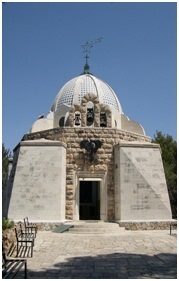
Shepherds' Fields - Bethlehem
The roads descending to the east of Bethlehem lead through the mostly Christian
village of Beit Sahour (or Bait Sahur), which includes the Shepherds' Fields: the
fields identified since ancient times with the shepherds who saw the Star of Nativity
And there were shepherds living out in the fields nearby, keeping watch over their
flocks at night. An angel of the Lord appeared to them, and the glory of the Lord
shone around them, and they were terrified. But the angel said to them, "Do not
be afraid. I bring you good news of great joy that will be for all the people."
(Luke 2:8-10) The fertile fields of Beit Sahour are believed to be where this biblical
scene took place. There are two rival locations for the exact site, one run by the
Greek Orthodox and the other by the Franciscans. Both sites have been excavated,
and there have been churches and monasteries on both sites since the 4th century
or earlier. This site interested the earliest Christian pilgrims; in 384 the pilgrim
Egeria was shown the church called "At the Shepherds" in a valley near Bethlehem.
She reported, "A big garden is there now, protected by a neat wall all around, and
also there is a very splendid cave with an altar." The pilgrim Arculf remarked in
670 that this site was "about a mile to the east of Bethlehem." The Orthodox site
seems to correspond better with Egregia and Arculf's accounts. This area is also
believed to be where the Hebrew matriarchs Ruth and Naomi gleaned in the fields
behind the harvesters on their way to Bethlehem from Moab (Ruth 2-4). Ruth married
Boaz, and they became parents of Oved, the father of Jesse. Jesse was the father
of King David, who was born in Jerusalem. Thus Bethlehem became known as the "City
of David" and it was predicted that the Messiah would be born there (Micah 5:1-5).
The Greek Orthodox site of the Shepherds' Fields is at Kanisat al-Ruwat in the middle
of fields 2 km southeast of Bethlehem. The ruins at al-Ruwat include a cave used
as a church from the 4th century, of which the barrel-vaulted roof (5th century)
still survives. It is approached by a flight of 21 steps and has three apses with
traces of mosaic and old frescoes. The mosaic floor includes crosses, and therefore
must predate 427, when this was forbidden as impious. The church at al-Ruwat served
the Orthodox community from the 5th century to 1955. It is the only 5th-century
church outside Jerusalem to survive intact. Above it a Byzantine chapel was built,
and was in turn replaced by a larger church, which was then destroyed in 614. It
and a monastery were rebuilt in the 7th century and survived until the 10th century.
Today, a new large church has been built, the 4th-century lower church has been
restored, and the remains of the upper church and monastery have been preserved.
About 600m to the north of al-Ruwat is the site the Roman Catholics (Franciscans)
identify as the Shepherds' Fields, at Khirbat Siyar al-Ghanim. Here there is a low
natural cave or rock shelter in pleasant surroundings and with a fine view of the
hills. The cave, with soot-blackened roof, has been partly enclosed to make a modern
chapel. Above is a modern church (1954) shaped like a tent and decorated with a
bronze angel. To the north are ruins of a rectangular monastery founded on a site
occupied by nomadic shepherds in the 1st century. An early phase is dated from the
late 4th century to the early 5th century and a second phase (which used stones
from the original apse of the Church of the Nativity to the 6th century. Only the
apse of the church survives, and a large lintel decorated with crosses. The monastery
had winepresses, bakery, cisterns and animal pens.
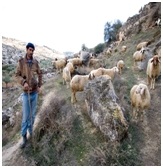
Scholars tend to believe this was probably not the site described by Egregia, but
simply one of many Byzantine monasteries of the Judean desert. It may have been
where Palladius began his monastic life with the miracle-worker Poseidonius in 419.
It was not reoccupied after being destroyed by the Persians in 614. There is also
a third site, which has no ancient remains. The YMCA of Beit Sahour, east of the
town center on the north side of the road, is where many Protestants commemorate
Shepherds' Fields. There is a grove of pines, a cave, and a view (not exceptional)
toward Jerusalem and the desert. Also of interest nearby is a small walled monastery
at Khirbat Abu Ghunain, located about 3km northeast of Bethlehem. A church with
a single apse lies on the north side of the monastery, which may be that of Photinus-Marinus,
founded in the 5th century by the brothers Marinus and Lukas, disciples of Euthymius.
This is one of many Byzantine monasteries founded in the area; there is another
2km northeast of Bethlehem at Bir al-Qutt.
This is a larger complex with a church on the north side, dated to the 6th century
and with Georgian inscriptions indicating a dedication to St. Theodore.
St Catherine’s Church - Bethlehem
The church is said to be built on the site of Christ’s appearance to St. Catherine
of Alexandria and his prediction of her martyrdom (c.310 AD). She is buried on Mt.
Sinai.
The church is first recorded in the 15th century and may incorporate the chapter
house of the 12th-century Crusader monastery that stood on the site. Traces of a
5th-century monastery associated with St. Jerome also exist here. St. Catherine’s
Church was enlarged in 1881 with funds from the Emperor of Austria. The modern basilica
has three aisles. To the north and west is the active Franciscan monastery. Outside
the west door of the church is a pleasant cloister, restored in 1948 by A.
Barluzzi using columns and capitals of the 12th-century monastery. The cloister
includes a modern statue of St. Jerome; the church facade is topped with a statue
of St. Catherine.
Just to the right upon entering the church, steps descend to more caves beneath
the Church of the Nativity. Here rock cuttings and ancient tombs with various modern
additions commemorate various people and traditions:
- Chapel of the Innocents – the tomb of infants slain by Herod the Great (Matt. 2:16)
- Chapel of St. Joseph – dedicated to the husband of Mary
- Tombs of the St. Paula and her daughter Eustochium, who made a pilgrimage with Jerome
c.485 and later settled in Bethlehem
- Tomb of St. Jerome, a church father from Italy who translated the Bible into Latin
(the Vulgate)
- Study of St. Jerome, where Jerome is said to have written and worked on his translation
- Tomb of Eusebius – Jerome’s successor as head of the monastery
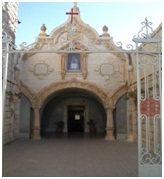
Milk Grotto - Bethlehem
The Milk Grotto (officially Magharet Sitti Mariam, "Grotto of the Lady Mary") is
a serene grotto only a few minutes' walk from Manger Square in Bethlehem. This grotto,
with a Franciscan chapel built above it, is considered sacred because tradition
has it that the Holy Family took refuge here during the Slaughter of the Innocents,
before their flight into Egypt. Tradition has it that while Mary was nursing Jesus
here, a drop of milk fell to the ground, turning it white. The irregularly shaped
grotto is hollowed out of the soft white rock. A church was built here by the 5th
century, and mosaic fragments on the terrace of the grotto, with geometrical motifs
and crosses, are thought to belong to this time. Both Christians and Muslims believe
scrapings from the stones in the grotto boost the quantity of a mother's milk and
enhance fertility. Mothers usually mix it in their drinking water; would-be mothers
place the rock under their mattress. There is also an old tradition that identifies
this as the burial site of the young victims of Herod's
(There is a chapel dedicated to them in the caves beneath the Church of St. Catherine.)
Slaughter of the Innocents.
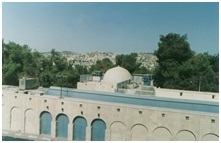
Rachel's Tomb- Near Bethlehem
Rachel's Tomb It is a significant historical and religious site for Muslims
and Christians. This site is believed to be the burial place of the biblical matriarch
Rachel, wife of Jacob and mother of two of his twelve sons. She died giving birth
to Benjamin and "Jacob set a pillar upon her grave" (Gen. 35:19). For Jews, Rachel's
Tomb is the third holiest site after the Temple Mount in Jerusalem and the Cave
of the Patriarchs in Hebron. It has become an important place of Jewish pilgrimage,
especially Jewish women unable to give birth. Jewish tradition has it that Rachel
weeps for her children and that when the Jews were taken into exile, she wept as
they passed by her grave on the way to Babylon (Jeremiah 31:11-16). The structure
on the site, a cube topped by a dome, was built around 1620 by the Ottoman Turks.
It was lengthened in
1860 by Sir Moses Montefiore.
In the 1990's, due to the deteriorating security situation, the original domed structure
was fortified and enclosed inside a building with a hall from the entrance. Recently,
the site has been surrounded by a barrier to separate it from Bethlehem. The site
consists of a rock with eleven stones upon it, one for each of the eleven sons of
Jacob who were alive when Rachel died in childbirth. Over the centuries, the rock
was covered by a dome supported by four arches. The large tomb is now covered by
a velvet drape. Today, the site is very close to the checkpoint from the Palestinian
territories into Israel. The original tomb, a rectangular structure with a white
dome, has been enclosed inside a fortress, complete with guard tower, soldiers and
barbed wire
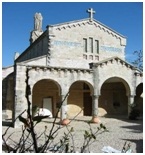
The village of Abu Gosh
This village is named after a notorious bandit who lived in the 19th century and
operated a very successful tollgate on the main road to Jerusalem which passes close
to the village. In biblical times its name was Qiryat Yearim and it was here that
the Ark of the Covenant was kept for 20 years before King David transported it to
Jerusalem, his new capital. On the top of the hill just outside the village is a
church to the Blessed Virgin Mary, one of whose earliest titles in the Church was
“Ark of the covenant” since she carried the word of God (Jesus) in her womb. This
present church is built on the remains of a byzantine church.
In the actual village is a beautiful Crusader church, one of the most beautiful
in the Holy Land, built to recall the story of the journey to Emmaus in St Luke’s
gospel. Abu Gosh is about a day’s journey from Jerusalem and so fits into the narrative
of the gospel a cube topped by a dome, was built around 1620 by the Ottoman Turks.
It was lengthened in 1860 by Sir Moses Montefiore.
In the 1990's, due to the deteriorating security situation, the original domed structure
was fortified and enclosed inside a building with a hall from the entrance. Recently,
the site has been surrounded by a barrier to separate it from Bethlehem. The site
consists of a rock with eleven stones upon it, one for each of the eleven sons of
Jacob who were alive when Rachel died in childbirth. Over the centuries, the rock
was covered by a dome supported by four arches. The large tomb is now covered by
a velvet drape. Today, the site is very close to the checkpoint from the Palestinian
territories into Israel. The original tomb, a rectangular structure with a white
dome, has been enclosed inside a fortress, complete with guard tower, soldiers and
barbed wire
Haifa
Haifa is a city in northwest Israel overlooking a bay on the Mediterranean Sea.
It has been compared by some to the similarly-situated cities of San Francisco or
Naples. A ferry service runs between Haifa and Athens. Israel's third largest city,
Haifa is a major industrial center and has a population of almost 300,000. According
to a popular Israeli saying, "Tel Aviv plays while Jerusalem prays. But Haifa works!"
Like most of Israel, Haifa has been populated since ancient times. Elijah is the
city's most famous early inhabitant; here he meditated in a cave before defeating
the priests of Baal. In April 22, 1948, the Arabs of Haifa surrendered to Israeli
forces and the town remains under Israeli rule today. Most of Haifa's Arab inhabitants
left after this, but the town still retains a cosmopolitan mixture of Muslim Arabs,
Christian Arabs, and Baha'is. Haifa has several important religious sites and attracts
many pilgrims and tourists alike each year.
Apart from its busy port on the bay, Haifa is situated on the northern slopes of
Mount Carmel, where there are quiet and attractive suburbs for the cities wealthy.
Residential and business districts are on the slopes, while the finest residences
and resort hotels are on the mountaintop, commanding scenic views of the entire
bay area. The lower and upper cities are linked by a cable car. Haifa also has the
only subway in Israel, the Carmelit, dating from 1959. Just to the south of Haifa
are magnificent beaches that locals flock to, but few tourists know about. Plans
are now in progress to convert these unspoiled beach areas into Haifa's own "Riviera."
There will be a great deal of hotel, apartment, and marina construction underway
along the shoreline during the next few years.
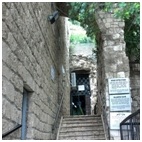
Elijah's Cave - Haifa
Elijah's Cave is nestled at the base of Cape Carmel in Haifa, below the lighthouse
and Stella Maris Carmelite Monastery. An important shrine to many religions, the
chapel includes the very cave in which the Hebrew prophet Elijah is believed to
have lived and taught.
Many important events in the life of the Prophet Elijah (9th century BC) are said
to have happened in this revered cave: he lived and meditated here before defeating
the pagan prophets of Baal on Mount Carmel; he hid here when fleeing the wrath of
King Ahab and his wife, Jezebel; and Elijah established his school here upon his
return from exile. The cave is sacred to Jews, Christians, Muslims, and Druze, all
of whom venerate the prophet Elijah. There was a mosque here until 1948. Tradition
also has it that the Holy Family (Mary, Joseph and Jesus) found shelter in this
cave for a night on their Return from Egypt.
A domed chapel enshrines the cave, which is underneath the main altar. The cave
itself also has a small altar. Pilgrimages and great ceremonies are held at this
cave many times each year. Head coverings must be worn in the cave; they are available
at the entrance

Stella Maris Carmelite Monastery -
Haifa
The Stella Maris Carmelite Monastery in Haifa, Israel, is a 19th-century monastery
located on the slopes of Mount Carmel. The site can be reached by cable car or on
foot. In the 12th century, during the Crusader occupation of the region, groups
of religious hermits began to inhabit the caves of this area in imitation of Elijah
the Prophet. Within a century, these monastic hermits were organized into the Carmelite
order and the Carmelite order spread throughout Europe. While the Carmelite orders
flourished in Europe throughout the Middle Ages, its founders on Mount Carmel were
exiled at the time of the Mamluk conquest in 1291 and did not return until the 18th
century. Construction of the present monastery and basilica was begun in 1836. An
earlier monastery complex on this site served as a hospital for Napoleon's soldiers
during his unsuccessful siege of Acre (Akko) in 1799.
Many abandoned French soldiers who were slaughtered by the Turks after Napoleon
had retreated.
Situated across the street from the Old Lighthouse, with a magnificent view of the
sea, the entire ensemble of buildings, including the Lighthouse, is known as "Stella
Maris." The Stella Maris church is a beautiful structure, with Italian marble so
brightly and vividly patterned that visitors sometimes think the walls have been
painted. Colorful paintings on the dome, done by Brother Luigi Poggi (1924-28),
depict episodes from the Old Testament, the most dramatic being the scene of Elijah
swept up in a chariot of fire. The statue of the Virgin Mary, carved from cedar
of Lebanon, is also notable. The cave situated below the altar, which you can walk
down into, is "Elijah's Cave," where the Old Testament prophet is believed to have
lived. Many little votive candles burn on the altar above the cave, each representing
a Carmelite community in another country (the United States has its candle up on
the left).
In the rooms to the right of the entryway, there is a charming nativity scene, a
museum with artifacts from the Byzantine church that once stood on this site, and
a small souvenir shop. One of the monks will gladly give you a free pamphlet with
information about the history of the site and the Carmelite order dating back to
the arrival of the crusaders on this mountain in the late 12th century. They will
answer any questions you may have, and guide you to the various interesting details
of the church. The pyramid in front of the church is a memorial to the French soldiers
who died here after Napoleon's retreat. It bears the inscription "How are the mighty
fallen in battle," from King David's lamentation over Saul and Jonathan.
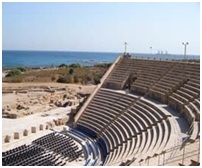
Caesarea Palaestina
Caesarea (also known as Caesarea Palaestina and Caesarea Maritima) is an ancient
city, now archaeological park, located on the Mediterranean Sea 33 miles north of
Joppa and 60 miles northwest of Jerusalem. Constructed by Herod the Great between
22 and 10 BC and named for Caesar Augustus, Caesarea was one of the most splendid
cities in Palestine and was the capital of the province for almost 600 years. Caesarea
also figures prominently in the religious history of the area. Herod built a great
Roman temple here dedicated to the Divine Augustus. Half a century later, Peter
and Paul visited the city (as recorded in the New Testament book of Acts). And towards
the end of the 1st century, mistreatment of Jews in Caesarea led to the First Jewish
Revolt (66-70 AD). In the 3rd and 4th centuries, Caesarea became a major center
of both Jewish and Christian scholarship, with several rabbinical schools and a
great library founded by Origen of Alexandria. Eusebius, the first church historian,
was bishop of Caesarea (315-30).
In the early middle Ages, the city traded hands between Muslims and Crusaders several
times; much of what remains dates from the Crusader era
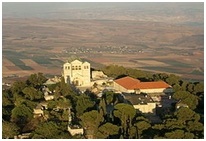
Mount Tabor -
Site of the Transfiguration of Christ
Mount Tabor is a hill rising 500m above the Jezreel Valley in the region of Galilee
(18 km) west of the Sea of Galilee. Due to its strategic location along the north-south
road, it has been an important fortress since ancient times. Christians have identified
a rock atop Mt. Tabor as the place of the Transfiguration of Christ since the 4th
century AD. In the Bible Deborah sent for Barak son of Abinoam from Kedesh in Naphtali
and said to him, "The LORD, the God of Israel, commands you: 'Go, take with you
ten thousand men of Naphtali and Zebulun and lead the way to Mount Tabor. I will
lure Sisera, the commander of Jabin's army, with his chariots and his troops to
the Kishon River and give him into your hands.'" (Judges 4:6-7)
You created the north and the south; Tabor and Hermon sing for joy at your name.
(Psalm 89:12) "As surely as I live," declares the King, whose name is the LORD Almighty,
"one will come who is like Tabor among the mountains, like Carmel by the sea. (Jeremiah
46:18) Jesus took with him Peter, James and John the brother of James, and led them
up a high mountain by themselves. There he was transfigured before them. His face
shone like the sun, and his clothes became as white as the light. Just then there
appeared before them Moses and Elijah, talking with Jesus. Peter said to Jesus,
"Lord, it is good for us to be here. If you wish, I will put up three shelters—one
for you, one for Moses and one for Elijah." While he was still speaking, a bright
cloud enveloped them, and a voice from the cloud said, "This is my Son, whom I love;
with him I am well pleased. Listen to him!" When the disciples heard this, they
fell facedown to the ground, terrified. But Jesus came and touched them. "Get up,"
he said. "Don't be afraid." When they looked up, they saw no one except Jesus. As
they were coming down the mountain, Jesus instructed them, "Don't tell anyone what
you have seen, until the Son of Man has been raised from the dead." (Mt 17:1-9)
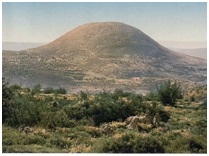
Due to its strategic importance, Mount Tabor has often been surmounted by a fortress.
Tabor was first occupied by a Seleucid fortress in the 3rd century BC. It was later
refortified in 66 AD by Josephus during the First Jewish Revolt, but fell to Roman
Emperor Vespasian in 67. In 348, Bishop Cyril of Jerusalem wrote that he preferred
Mt. Tabor to Mt. Hermon as the site of the Transfiguration, and by the end of the
4th century there was a church on the site. By 570, three Byzantine churches are
recorded as standing on Mt. Tabor, or perhaps one large church with chapels dedicated
to Christ, Moses and Elijah. By the 7th century, there was a fortifed Monastery
of the Transfiguration associated with Armenian monks atop Mt. Tabor. A Greek bishop
is mentioned in the 9th century. Mount Tabor was an important sacred site in the
Crusader period,and many hermits lived in cells on the mountain slopes.
A Latin abbot was appointed to the monastery soon after 1099 and the Greek Orthodox
monastery was put to us as a Benedictine house under a bishop in 1103-28.
The three Byzantine churches or chapels were still standing at this time. Islamic
forces raided the monastery in 1113, but it was re-established by 1115. At some
point in the 12th century, the old Byzantine triple church was replaced with a Romanesque
basilica with three aisles, six bays and three apses. It enclosed the sacred rock
that was believed to be the very site of the Transfiguration.
Stretching north and south of the church were the extensive buildings of a Benedictine
monastery, including a chapel and a small bath house. In 1183, part of Salah al-Din's
army climbed Mount Tabor and sacked the Greek monastery, but failed to take the
larger fortified Latin monastery until 1187. Beginning in 1212, Ayyubid leaders
al-Adil and later al-Mu'azzam Isa built massive walls and fortifications across
the entire high plateau of Mount Tabor in order to guard the road to Acre. The wall
was defended by 13 towers and a rock-cut ditch. But after a nearly-successful Crusader
attack in 1217, al-Mu'azzam demolished the fortifications. Throughout this period,
the Basilica of the Transfiguration seems to have survived intact and pilgrims continued
to visit it. Mount Tabor was back in Frankish hands from 1229 to 1241. In 1255,
it was granted to the Hospitallers, but in 1263, Baybars destroyed the church and
the mountain became a royal hunting park for the Mamluks. In the 14th century, local
Christians are recorded as decking the ruined churches atop Mount Tabor with flags
at the Feast of the Transfiguration (August 6), a custom that continued for many
centuries. In 1631, Fakhr al-Din granted the Franciscans permission to live atop
Mount Tabor, and this permission was confirmed by the Ottoman government on various
occasions in the 17th and 18th centuries. The Franciscans mainly used rooms of the
ruined castle bath house until they rediscovered the ruined Crusader church in 1858
and began reconstruction. In 1924, the present church, which stands over the 12th
century church, was completed.
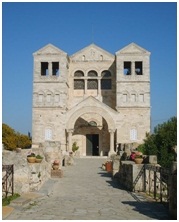
Mount Tabor can be seen from miles around and there are fine views across the Jezreel
Valley from the top, demonstrating its strategic importance. The 13th-century walls
can still be seen around the summit, which is divided into Greek Orthodox (northeast)
and Latin Catholic (southeast) areas. On the west side are ruins of Josephus' fortifications.
The Latin section is reached through the Gate of the Winds, which was al-Adil's
main fortress gate. The Latin (Franciscan) Church of the Transfiguration (or Church
of the Savior) dates from 1924 but stands on the same site and reflects the plan
of the earlier Crusader and Byzantine churches. In the crypt, the west door is now
blocked by the new entrance and the lowered floor of the nave. The chapel south
of the west entrance had a 12th-century wall tomb and a mosaic floor, which was
relaid in 1924. About 20m west of the church, on the north side of the entrance
path, is a small ruined chapel that may have been the private chapel of the abbot
in the 12th century. The entrance is in the west end of the south wall, a bench
lines the walls and the base of a chancel screen can be seen. Two steps lead up
to the sanctuary where a projection on the upper step marks the original location
of the altar (the present altar is modern). The apse has remains of a window and
two aumbries. In the Greek area is the Church of St. Elias, built in 1845. It is
a three-aisled basilica with four bays and the lower part of its apses may be early
12th century.
The wall paintings were added in 1912. Representing the ascetic hermit tradition
on Mount Tabor is the Church of St.
Melchizedek, located on the northwest side of the upper plateau. The name derives
from a 4th-century tradition in which Melchizedek spent seven years as a hermit
on Mount Tabor before meeting and blessing Abraham. Most of the present church dates
fromthe 19th century, but reuses older masonry
The Church of the Transfiguration is a Franciscan church located on Mount Tabor.
It is traditionally believed to be the site where the Transfiguration of Christ
took place, an event in the Gospels in which Jesus is transfigured upon an unnamed
mountain and speaks with Moses and Elijah
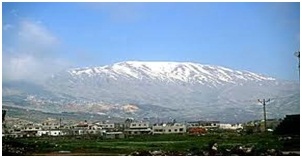
Mount Hermon
Jebel esh-Sheikh. Prominent Mountain (9,230 ft) on the northern border of Israelite
territory. At the southern end of anti-Lebanon is Mount Hermon, its highest peak.
We are told that the Sidonians said to, "this mountain Sirion; the Amorites call
it Shenir." It is also called Sion. Baal-Gad, a town under Mount Hermon has been
identified with Caesarea Philippi, which happens to be the northernmost place that
Christ journeyed. Mount Hermon, in the vicinity of Caesarea Philippi could very
possibly be the place Of His transfiguration. "The tower of Lebanon" in the Song
of Solomon (looking towards Damascus) is supposed to be Mount Hermon. Also many
rivers receive their flow from the mountains of Lebanon; some of them include rivers
mentioned in the Bible. Deut. 3:8-9; Josh. 11:3; 12:1..
Nazareth
Nazareth (Arabic an-Nāzirah) is a town in northern Israel, 88 miles north of Jerusalem.
Nazareth has a population of about 60,000, of whom half are Arab Muslim and half
are Arab Christian. Nazareth was the hometown of Jesus and thus is one of the most
important Christian sites in the Holy Land. Christian pilgrims have been coming
to Nazareth ever since the 4th century. Important sights in Nazareth include several
churches, traditional biblical sites, Byzantine ruins, and especially the modern
Basilica of the Annunciation, which stands over the traditional site of Gabriel's
announcement to Mary that she would give birth to the savior of the world.
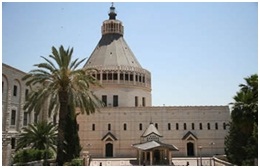
Basilica of the Annunciation- Nazareth
The Basilica of the Annunciation in Nazareth is a modern Catholic church built over
the remains of Byzantine and Crusader churches. It incorporates the cave in which
the Virgin Mary received the news from Gabriel that she would give birth to Jesus.
The site has been a pilgrimage destination since earliest times and remains an important
stop for Holy Land pilgrims today
Early sources on Nazareth's history are scarce, but Eusebius says Nazareth was a
small Jewish town in the Roman and Byzantine periods. Evidence of Jewish converts
to Christianity in Nazareth is provided by the historian Africanus in the 3rd century
and pilgrimage to Nazareth is first attested in the late 4th century. The cave that
is enshrined inside the basilica was identified no later than the 4th century as
the place of the Annunciation.
It is not known when the first church was built here, but one probably existed by
the early 4th century. An altar is referred to in c.384 AD and a church is mentioned
by c.570 AD. A Byzantine church has been excavated beneath the current church, which
dates from the 4th or 5th century. It had three aisles, a single projecting apse
and a large atrium. A small monastery was built south of the church. Inc.680, the
pilgrim Arculf recorded seeing two churches in Nazareth, one at Mary's spring and
the other on the traditional site of the Annunciation, where the basilica stands
today. The Byzantine church on the site of the Annunciation survived as late as
the 9th century, when 12 monks associated with the church are mentioned in the Commemoratorium
of 808 AD. The church was apparently destroyed before or during the Crusades; the
Abbot Daniel recorded in 1106-08 that it had been laid waste but thoroughly rebuilt
by Tancred and the Franks.
The Crusader church was larger than the Byzantine church over which it was built.
The church had three aisles and six bays, probably with a crossing covered by a
dome fronting three apses. An edicule in the north aisle covered the House of Mary
on a lower level. Much money and effort was put into the decoration of the Crusader
church, which included magnificent capitals carved with scenes from the lives of
the Apostles by French craftsmen. There were monastery buildings on the south side
and a bishop's palace on the north side.After the Battle of the Horns of Hattin
in 1187, the Christian inhabitants of Nazareth took refuge in the church but was
slaughtered. The church was thereby profaned, but it was left standing.
In 1192, Salah al-Din allowed a few clergy to return and granted Christian access
to the shrine. St. Louis made a pilgrimage here in 1251.However, in 1263, an emir
of Baybars attacked Nazareth and razed the church to the ground. Pilgrims were still
allowed to visit the grotto (which was venerated also by Muslims), but in 1283 Christians
were explicitly forbidden to rebuild the church. By the 14th century, pilgrims were
charged an entrance fee by the Muslims guarding the grotto. The site of the church
was filled with garbage and was later used for stabling cattle. The Franciscans
established a monastery in Nazareth in the 14th century and appear to have gained
control of the holy site for a period in the mid-16th century. They restored and
occupied the former bishop's palace and began to repair the church in 1620. However,
they were expelled several times throughout the 1600s. In 1730 the Franciscans finally
completed a new church, which was enlarged in 1871. The Franciscan church was demolished
in 1955 for the construction of the present church, which was built over the Crusader
and Byzantine foundations. It was consecrated in 1969. Today, the Basilica of the
Annunciation is the parish church for 7,000 Catholic Christians in Nazareth and
the focal point of Catholic and Protestant pilgrimages.
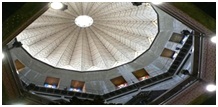
The modern Church of the Annunciation is topped with a uniquely-shaped concrete
dome 55 meters high. Its shape is based on the Madonna lily, a symbol of the Virgin
Mary. Inside, the basilica consists of an upper church and a lower church. The vast
upper church is decorated with mosaics of the Virgin donated by communities from
around the world. The lower church centers on the Grotto or Cave of the Annunciation,
where the angelic announcement to Mary is believed to have occurred. Also visible
down here are remains of the Byzantine and Crusader churches that preceded the present
one.
Church of St. Gabriel -Nazareth
The Church of St. Gabriel is the Orthodox counterpart to the Catholic Basilica of
the Annunciation in Nazareth. According to Orthodox tradition, the Virgin Mary first
received the news from Gabriel that she would bear the Savior while she was out
fetching water. The Orthodox Church of St. Gabriel is therefore located over the
spring that fed Mary's Well, the traditional place where Mary fetched water for
her household.

Although not recorded in the Bible, the tradition of Mary receiving the Annunciation
while fetching water is ancient. It is written down in the 2nd-century Christian
text known as the Protevangelium of James, which fills out the biblical story of
Mary and the birth of Jesus with more details. The Protevangelium (or Proto-Gospel
of James) says that Mary was one of seven unblemished virgins from the line of David
chosen to weave a new curtain for the Holy of Holies in the Jerusalem Temple. She
was working on this task in her Nazareth home when she went out to fetch some water
from the city well. "She took the jar and went out to fetch water. Then a voice
spoke to her: 'Greetings, you who have received grace. The Lord is with you, you
blessed among women.' She looked right and left to see where the voice came from
and began to tremble. Then she went back into the house, put the jar aside, sat
down, took the purple and began to spin. Then an angel stepped before her..." The
biblical account in Luke 1:26-38 only says that "God sent the angel Gabriel to Nazareth"
and that "the angel went to her." It does not record the place of the Annunciation
or what Mary was doing at the time. The Church of St. Gabriel is built over "Mary's
Spring," a natural spring that feeds the nearby ancient well known as Mary's Well.
There may have been a Byzantine church here by the 6th or 7th century, but the first
certain mention of it is by Abbot Daniel in 1106-08. St. Gabriel's Church was probably
always an Orthodox church, but there is some historical uncertainty about what happened
during the Crusades - a few years following the conquest, Crusader sources mention
a Latin priory of St. Gabriel. From the 14th century, the church fell into increasingly
bad repair, but there was always access to the chapel containing the sacred spring.
The site was owned by the Franciscans and Greek Catholics for some time, but in
1741 the Greek Orthodox community gained permission from Dahir al-Umar to take over
the site. In 1750, the Orthodox community built the present church on the south
side of the chapel with the spring. The wooden iconostasis was added in 1767.
The upper church has a fine wooden iconostasis, with delicate carvings and painted
icons. From the north aisle of the 18th-century church, seven steps descend to the
lower chapel of the spring. Here a narrow single aisle, sometimes crowded with pilgrims,
is roofed by a barrel vault and lined with blind arcades decorated with colored
marble and glazed ceramic from c.1750. At the north end of the chapel, Mary's Spring
runs beneath an altar and can be peered down into. The round stone well has a lamp
hanging over it and many icons of Mary have been set up around its rim. According
to a 17th-century account (the Quaresmi), a now-blocked stair on the right originally
led up to convent of nuns and there was an altar in the east wall (now covered with
arcades). The remains of a Byzantine bath house have recently been uncovered in
the area and can be seen in a nearby cafe.
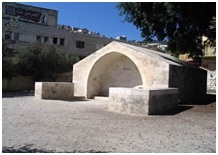
Mary's Well -Nazareth
Mary's Well is a modern public fountain in Nazareth built over a well that
has been in public use since ancient times. It is fed by Mary's Spring, which runs
under the altar of the nearby Orthodox Church of St. Gabriel. Although not recorded
in the Bible, the tradition of Mary receiving the Annunciation while fetching water
is ancient. It is written down in the 2nd-century Christian text known as the Protevangelium
of James (or Proto-Gospel of James), which fills out the biblical story of Mary
and the birth of Jesus with more details. The Protevangelium says that Mary was
one of seven unblemished virgins from the line of David chosen to weave a new curtain
for the Holy of Holies in the Jerusalem Temple. She was working on this task in
her Nazareth home when she went out to fetch some water from the city well. "She
took the jar and went out to fetch water.
Then a voice spoke to her: 'Greetings, you who have received grace. The Lord is
with you, you blessed among women.'
She looked right and left to see where the voice came from and began to tremble.
Then she went back into the house, put the jar aside, sat down, took the purple
and began to spin. Then an angel stepped before her..." The biblical account in
Luke 1:26-38 only says that "God sent the angel Gabriel to Nazareth" and that "the
angel went to her." It does not record the place of the Annunciation or what Mary
was doing at the time.
Even for those who do not accept the tradition of the Annunciation at the well,
Mary's Well is significant as the likely spot at which Mary would have fetched water
on a regular basis. When Jesus was a boy, she would have brought him along with
her. The structure seen today was is a 1960s reconstruction of a well-house from
the 19th century and stands over the ancient public well possibly used by Mary.
Today, water no longer flows to Mary's Well. Recent excavations have uncovered possible
Byzantine and especially Crusader-era tunnels running from the well to houses in
the area. Pottery from the 2nd century AD was also found here.
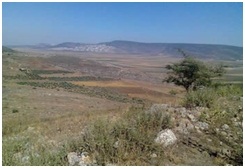
Cana Jesus' first miracle
Cana (modern name
Kafr Kanna; also known as
Khirbet Cana) is
a Galilean town five miles northeast of Nazareth. Its population of 8,500 includes
both Muslims and Christians. Long revered as the site of Jesus' first miracle or
turning water into wine at a wedding, Kafr Kanna has good historical support for
its authenticity as ancient Cana. In the Bible, on the third day a wedding took
place at
Cana in Galilee. Jesus' mother was there, and Jesus and his disciples
had also been invited to the wedding. When the wine was gone, Jesus' mother said
to him, "They have no more wine.""Dear woman, why do you involve me?" Jesus replied,
"My time has not yet come." His mother said to the servants, "Do whatever he tells
you." Nearby stood six stone water jars, the kind used by the Jews for ceremonial
washing,each holding from 20 to 30 gallons. Jesus said to the servants, "Fill the
jars with water"; so they filled them to the brim.
Then he told them, "Now draw some out and take it to the master of the banquet."
They did so, and the master of the banquet tasted the water that had been turned
into wine.
He did not realize where it had come from, though the servants who had drawn the
water knew. Then he called the bridegroom aside and said, "Everyone brings out the
choice wine first and then the cheaper wine after the guests have had too much to
drink; but you have saved the best till now." This, the first of his miraculous
signs, Jesus performed in
Cana of Galilee. He thus revealed his glory, and
his disciples put their faith in him. (John 2:1-11)
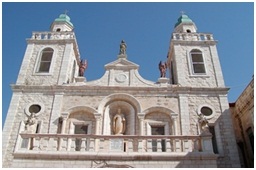
History records that a church was built in Cana by Empress Helena (mother of Constantine)
in the 4th century, and this was identified with the remains of a large building
found by travellers to Kafr Kanna in the 17th century. Recent excavations have uncovered
ruins of houses from the 1st-4th centuries AD, of a 5th-century atrium with portico,
a Christian funerary building from the 5th or 6th century, and a medieval building.
The land at Kafr Kanna was sold by the lord of Sidon to the Knights Hospitallers
in 1254. The Franciscans became established here in 1641 and began building the
present church over an older church in 1879. It was consecrated in 1883. The
Franciscan
Wedding Church at Cana is small and fronted by a courtyard. The facade has
angel figures and is flanked by two bell towers and over an arcaded narthex. Inside,
the church has two levels.The upper church has a chapel surmounted by a simple dome.
In the nave just before the stairs is a fragment of a
Byzantine mosaic dating
from the 5th or 6th century and preserves the name
of the donor in Aramaic: "In memory of the pious Joseph, son of Tanhum, son of Bota
and of his children who made this table, may it be for them a blessing, Amen." The
lower church has a chapel and a small museum with artifacts from the site, including
a winepress, a plastered cistern and vessels of various dates. One old jar is said
to be one of the six jars used for the miracle. Opposite the Franciscan church is
a
Greek Orthodox Church?, which is usually closed. Two 13th-century capitals
are displayed near it. The
ruins of ancient Cana are on top of a small rounded
hill rising 60m above the plain. They can be seen on the eastern slope (Byzantine
and early Arabic), around the top slopes, and on the peak (mostly Greek and Roman).
The local shop in Kafr Kanna sells "wedding wine" and related souvenirs.
Sea of Galilee
Also known as Bahr Tubariya, Ginnosar, Lake of Galilee, Lake of Gennesaret, Lake
of Gennesar, Sea of Chinnereth, Sea of Chinneroth, Sea of Kinnereth, Sea of Tiberias,
Lake of Tiberias, Waters of Gennesaret, Yam Kinneret
The Sea of Galilee is located in the east side of the Galilee, in the north of Israel.
It is a large sweet water lake (168 square KM), has 55KM of shore line, 21KM long
X 12KM wide (at its widest section at the Arbel cliffs), and has a kind of the shape
of a pear or a violin. The lake is shallow - the maximum depth is 44M. The entire
lake is located within a great depression, about 210M below the (Mediterranean)
sea level. It is the lowest sweet water lake in the world. The hills around the
lake are even higher: 400-500M above the lake's level. This depression is part of
the Syrian-African fault line, which includes the Dead Sea
The Sea of Galilee is mentioned in The Bible by 3 other names:
- The Sea of Kinnereth (or Chinnereth), from its harp-like shape.
- The Sea of Tiberias.
- The Lake of Gennesareth.
Much of the ministry of Jesus Christ, and numerous of His miracles took place in
the area of the Sea of Galilee. From the fishermen of the Sea of Galilee came at
least four of The Twelve Apostles - Peter, Andrew, James and John Jesus stilled
the raging storm on the Sea of Galilee that was about to swamp their boat. Jesus,
and Peter to a limited extent, walked on the water there. Near its shores Jesus
fed the five thousand men, women and children from the miraculous multiplication
of five loaves of bread and two fish. Mary of Magdala, the first human to see and
speak with the Savior after His resurrection, was from the town of Magdala on the
western shore of the Sea of Galilee.
Tabgha (Place of the Seven Springs)
Tabgha (also spelled
Tabhka) is not a city, but a small area on the
northwest shore of the Sea of Galilee, not far from Capernaum. In ancient times,
Tabgha was known as
Heptapegon - "Place of the Seven Springs." These seven
springs produce warm water, which increases the production of algae in this part
of th e lake, which attracts more fish. Fisherman has thus flocked to Heptapegon
for thousands of years. By the 4th century AD, Heptapegon had become a popular place
for Byzantine pilgrims to rest and have their picnics, thanks to its shady trees
and excellent fishing. It is probably not coincidence that two of the three pilgrimage
destinations in this relate to abundant food: the miracle of the loaves and fishes
during Jesus' Galilean ministry and a lakeside fish breakfast after Jesus' resurrection.
A hill above the two lakeside churches is commemorated as the Mount of Beatitudes,
from which Jesus spoke the most famous sermon in history. Tabgha is a beautiful
area with many interesting things to see, and is a major stop for modern pilgrimages
to the Christian sites of the Sea of Galilee. It is only a few miles from Capernaum
(to the north) and the Galilee Boat (to the south).
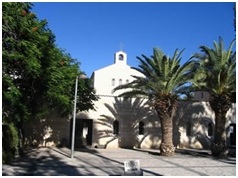
Church of the Loaves and Fishes-Tabgha
The
Church of the Multiplication of the Loaves and Fishes (also known as
the Church of the Multiplication) is a church in Tabgha (ancient Heptapegon) on
the northwest shore of the Sea of Galilee. The church is modern but stands on the
site of 4th and 5th-century churches. It preserves a splendid early Christian mosaic
as well as the traditional stone on which the miraculous meal was laid. In the Bible,
The miraculous feeding of five thousand people is described in Mark 6:30-44, just
before Jesus walks on water. The Gospel account of the loaves and fishes does not
specify where it took place; only that it was in a "remote place" (6:32,35) on the
shores of Galilee. According to Mark's account, Jesus and his disciples had gone
out in a boat to this remote place for some peace and quiet, but the crowds ran
ahead "from all the towns" and met him when he landed. By then it was dinnertime
and they were not in a village where food could easily be bought,
so Jesus fed them all by miraculously multiplying his disciples' five loaves and
two fishes.Then Jesus directed them to have all the people sit down in groups on
the green grass. So they sat down in groups of hundreds and fifties.
Taking the five loaves and the two fish and looking up to heaven, he gave thanks
and broke the loaves.
Then he gave them to his disciples to set before the people. He also divided the
two fish among them all. They all ate and were satisfied, and the disciples picked
up twelve basketfuls of broken pieces of bread and fish. The number of the men who
had eaten was five thousand. (Mark 6:40-44)
It is possible that this is the actual site of the Feeding of the Five Thousand,
but not terribly likely. Scholar Jerome Murphy O'Connor attributes the selection
of the site to pilgrims' associations with the area: It was perhaps inevitable that
this well-watered area with its shade trees on the shore of the Sea of Galilee,
where Byzantine pilgrims ate their picnics, should have been identified as the location
of two episodes involving the consumption of food, the multiplication of the loaves
and fishes and the conferral on Peter of the responsibility of leadership after
a fish breakfast. Then it became convenient to localize the Sermon of the Mount
on the small hill nearby. (Oxford Archaeological Guides: The Holy Land, p. 277)
A church of the Feeding of the Five Thousand was first built on this site in c.350.
The church was small (15.5m x 9.5m) and on a slightly different orientation than
the later versions. The Spanish pilgrim Egeria visited this church in the 380s,
and reported: By the sea is a grassy field with plenty of hay and many palm trees.
By them are seven springs (heptapegon), each flowing strongly. And this is the field
where the Lord fed the people with the five loaves and two fishes. In fact the stone
on which the Lord placed the bread has now been made into an altar. People who go
there take away small pieces of the stone to bring them prosperity, and they are
very effective. (trans. J. Wilkinson) The church was significantly enlarged around
480 — an inscription attributes its building to the patriarch Matryrios (478-86)
— which included the addition of the splendid floor mosaic. The mosaics were repaired
in the 6th century and the church was destroyed around 685 AD. The site was bought
by the Deutsche Verien vom Heilige Lande and excavated in 1932; a protective cover
was built over the mosaics in 1936. In 1982 this was replaced by the modern Church
of the Multiplication of the Loaves and Fishes that stands today, which is a faithful
reconstruction of the original.

Under the altar table is a block of limestone (1 x 0.6 x 0.14m) venerated
as the table of the Lord. This is unlikely to be the same one Egeria saw in the
4th century (see History, above), and of course pilgrims are no longer permitted
to chip away at it! In front of the altar is a lovely restored mosaic of
two fish flanking a basket of loaves. Besides its sacred importance as the place
of a miracle of Jesus, the main highlight of the Church of the Loaves and Fishes
is this beautiful 5th-century figurative mosaic floor. It is the earliest
known example of a figured pavement in Palestinian Christian art. The main mosaic
covers the two transepts and the intervals between the pillars (the rest of the
floor has a mosaic in a simple geometric pattern, mostly restored). The principal
mosaic was clearly designed by a great master who was able to create a free-flowing
design without need of any repetitious pattern.
The mosaic depicts birds and plants, with a prominent place given to the bell-like
lotus flower. This flower is not found in the area and indicates the influence of
the Nilotic landscapes then popular in Hellenistic and Roman art. However, all the
other motifs depict flora and fauna from Galilee - the level of detail allows the
identification of each species. There are charming "ducks in love" in the lower
center and a depiction in the upper left of the round tower (nilometer) that was
used to measure water level. Also visible are the Greek letters for the numbers
6 to 10. A few other parts of the 5th-century Byzantine church are preserved
in the modern church, including the sill of the left entrance to the atrium, some
of the basalt paving stones of the atrium, and part of the frieze in the apse. The
foundations of the original 4th-century church can be seen under a glass
panel. Old basalt presses and a font are displayed in the courtyard.
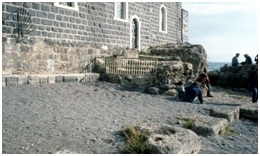
Church of the Primacy of Peter-Tabgha
The
Church of the Primacy of Peter is a modest Franciscan chapel that incorporates
part of a 4th-century church. It is located at Tabgha on the northwest shore of
the Sea of Galilee and commemorates Jesus' reinstatement of Peter after a fish breakfast
on the shore. In the Bible, In John 21, Jesus appears to his disciples for the third
time after his resurrection on the shores of the Sea of Galilee. The night before,
Peter and several other disciples had sailed out on the lake to fish, but caught
nothing. In the morning, a man appeared on the shore and called out to them to throw
their net on the right side of the boat. Doing so, they caught so many fish they
couldn't drag the net back into the boat. At this point Peter recognizes Jesus,
and promptly jumps out of the boat to wade to shore to meet him. The other disciples
follow in the boat, dragging the net behind them.
When they land, Jesus has prepared a charcoal fire for the fish and provided bread,
and they have breakfast together (John 21:9).
This is believed to have taken place on the mensa Christi, a large rock incorporated
in the chapel. After breakfast, Jesus reinstated Peter (after his three-time denial
of Jesus at the crucifixion) with the words "Feed my sheep" (John 21:15-19). This
is the event for which the modern church is named, which is interpreted by the Catholic
Church to give the Pope (as the successor of Peter) authority over the worldwide
Church.
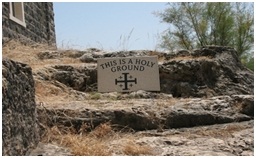
Sometime around 381, the Spanish pilgrim Egeria visited the area and reported that
next to the Church of the Loaves and Fishes "are some stone steps where the Lord
stood" (John 21:4). Egeria does not mention a church here, but one was built on
the site by the end of the 4th century. It was roughly the same size and shape as
the original Church of the Loaves and Fishes and its east end enclosed a flat rock
identified as the table on which Jesus offered breakfast to the disciples (John
21:9). In the 9th century, the church is referred to as the Place of the Coals.
By this time (first mentioned 808 AD), the Twelve Thrones had been placed along
the shore to commemorate the Twelve Apostles. The church survived longer than any
other church in the area, and was finally destroyed in 1263. The present Franciscan
chapel was built on the site in 1933. The Franciscan chapel is small and made of
grey stone, with a modest tower in one corner.
It is pleasantly located right on the northwest shoreline of the Sea of Galilee.
At the base of the chapel's walls on the west end, the walls of the late 4th-century
church are clearly visible on three sides. Like the early church, the modern chapel
incorporates a large portion of the stone "table of Christ" (Latin: Mensa Christi)
at the altar. This is where Jesus is believed to have served his disciples a fish
breakfast after they landed on shore (John 21:9). On the lake side of the church
are the rock-cut steps mentioned by Egeria as the place "where the Lord stood."
It is not known when they were carved, but it may have been in the 2nd or 3rd century
when this area was quarried for limestone. Below the steps are six heart-shaped
double-column blocks known as the Twelve Thrones, which can be under water when
the lake level is high. Originally designed for the angle of a colonnade, they were
probably taken from disused buildings and placed here to commemorate the Twelve
Apostles. The association likely derived from Luke 22:30: "You will eat and drink
at my table in my kingdom, and you will sit on thrones to judge the twelve tribes
of Israel." Just beside the church is a small Crusader building. Also nearby are
Byzantine water towers that were designed to raise the water level of the powerful
springs so that they flowed into a series of irrigation canals and mill-streams.
The mills are modern. A little further inland from the Church of the Primacy of
Peter is the Church of the Loaves and Fishes, which is well worth a visit.
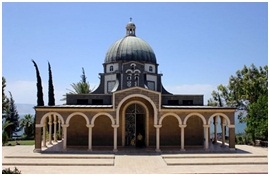
Mount of Beatitudes- Tabgha
Located on a small hill overlooking the Sea of Galilee near Tabgha, the
Mount of
Beatitudes is the traditional site of Jesus' delivery of the Sermon on the
Mount, probably the most famous sermon of all time. Pilgrims have been drawn to
this scenic place since at least the 4th century. In the Bible, "Now when he saw
the crowds, he went up on a mountainside and sat down. His disciples came to him,
and he began to teach them, saying: Blessed are the poor in spirit, for theirs is
the kingdom of heaven. Blessed are those who mourn, for they will be comforted.
Blessed are the meek, for they will inherit the earth." (Mt 5:1-5)
It is
possible that this is the actual site of the Sermon on the Mount, but
it is not terribly likely. There is no specific evidence for identification of the
site before the 4th century, but it is reasonable to place the Sermon here since
Jesus was based in Capernaum
not far away.
Jerome Murphy O'Connor attributes the selection of the site to pilgrims' own experiences
in the area: It was perhaps inevitable that this well-watered area with its shade
trees on the shore of the Sea of Galilee, where Byzantine pilgrims ate their picnics,
should have been identified as the location of two episodes involving the consumption
of food, the multiplication of the loaves and fishes and the conferral on Peter
of the responsibility of leadership after a fish breakfast. Then it became convenient
to localize the Sermon of the Mount on the small hill nearby. (Oxford Archaeological
Guides: The Holy Land, 277) Regardless of whether this is the very spot, the Church
of the Beatitudes stands in the right general area and in a very similar setting
to where Jesus would have stood as he delivered his famous sermon. As Murphy-O'Connor
puts it, from here "one can see virtually all the places in which Jesus lived and
worked" (p.280).
Pilgrims are known to have commemorated the Sermon on the Mount near here since
the 4th century. After describing the Church of the Loaves and Fishes, the Spanish
pilgrim
Egeria (c.381) wrote, "Near there on a mountain is the cave to which
the Savior climbed and spoke the Beatitudes." Ruins of a small church dated to the
late 4th century have been discovered downhill from the present church. It
has a rock-cut cistern beneath it and the remains of a little monastery to its south
and southeast. Part of the mosaic floor was recovered and is now on display in Capernaum.
The present church was built in
1938.
Designed by the architect A. Barluzzi, the Catholic
Church on the Mount of
Beatitudes is Byzantine in style. Its octagonal shape represents the eight beatitudes.
It has a marble veneer casing the lower walls and gold mosaic in the dome. The chief
attraction here, though, is the
setting. The cool and quiet gardens overlooking
the Sea of Galilee and the landscape where Jesus conducted his ministry make an
excellent place to contemplate some of the best-known Christian teachings.
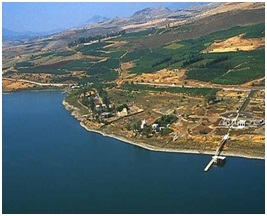
Capernaum - Where Jesus Taught and
Peter Lived
Capernaum is an ancient fishing village on the north shore of the Sea of
Galilee. It is home to a celebrated Byzantine-era synagogue as well as the house
where Jesus healed a paralytic and St. Peter's mother-in-law. Capernaum is frequently
mentioned in the Gospels and was Jesus' main base during his Galilean ministry.
It is referred to as Jesus' "own city" (Mt 9:1; Mk 2:1) and a place where he lived
(Mt 1:13). He probably chose it simply because it was the home of his first converts,
Peter and Andrew (Mk 1:21, 29). They went to
Capernaum, and when the Sabbath
came, Jesus went into the synagogue and began to teach. The people were amazed at
his teaching, because he taught them as one who had authority, not as the teachers
of the law.... As soon as they left the synagogue, they went with James and John
to the home of Simon and Andrew. Simon's mother-in-law was in bed with a fever,
and they told Jesus about her. So he went to her, took her hand and helped her up."
(Mark 1:21-22, 29-30) Many familiar Gospel events occurred in this village. Capernaum
is where Jesus first began to preach after the Temptation in the wilderness (Mt
1:12-17) and called Levi from his tax-collector's booth (Mk 2:13-17).
It was while teaching in the synagogue of Capernaum that he said, "Whoever eats
my flesh and drinks my blood has eternal life, and I will raise him up at the last
day." (Jn 6:54) Capernaum is where Jesus healed a centurion's servant without even
seeing him (Mt 8:5-13; Lk 7:1-10), Peter's mother-in-law (Mt 8:14-15; Mk 1:29-30);
the paralytic who was lowered thorugh the roof (Mk 2:1-12), and many others who
were brought to him (Mt 8:16-17). And it was Capernaum that Jesus had set out from
when he calmed a storm on the Sea of Galilee (Mt 8:23-27).
Jesus was harsh with his adopted home when it proved unrepentant despite his many
miracles. "And you, Capernaum, will you be lifted up to the skies? No, you will
go down to the depths. If the miracles that were perfor med in you had been performed
in Sodom, it would have remained to this day. But I tell you that it will be more
bearable for Sodom on the Day of Judgment than for you" (Mt 11:23-24).
It is actually quite likely the room enshrined within the church of Capernaum is
the house of Peter where Jesus stayed. This is supported primarily by evidence for
very early reverence and public use of the house (mid-1st century), which would
be difficult to explain otherwise. Moreover, the identification is not contradicted
by anything found in the excavations and the evidence actually conforms quite closely
to the biblical descriptions. Read on for more details. Now predominantly an archaeological
park, Capernaum was originally a
fishing village inhabited continuously from
the 1st century BC to the 13th century AD. As the first town encountered by travelers
on the other side of the Jordan, it was equipped with a customs office and a small
garrison overseen by a centurion.
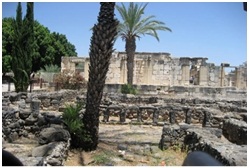
Capernaum was a Jewish village in the time of the Christ. It was apparently poor,
since it was a Gentile centurion that built the community's synagogue (Luke 7:5).
The houses were humble and built of the local black basalt stone. Christian presence
is attested early in Capernaum and the village was predominantly Christian by the
4th century AD. Rabbinic texts from the 4th century imply considerable tension between
the Jewish and Christian communities of the town. Both the church and synagogue were
destroyed prior to the Islamic conquest in 638. One possible scenario is
that the Persian invasion of 614 gave the Jews the opportunity to act on their resentment
of the now-powerful Christian community and demolish the church. In 629, the Byzantine
emperor and his troops marched into Palestine, and under this protection the Christians
may have destroyed the . synagogue. After the conquest, the village shifted east,
where houses, a jetty, a fish market and a church dedicated to St.
John Theologos existed until the mid-10th century. The town's prosperity was badly
affected by an earthquake in 746 and never recovered. In the Crusader period, Capernaum
was all but abandoned. The site was too exposed for Crusaders to safely build there,
despite their considerable interest in its religious importance. In the 13th century,
a visitor reported that "the once renowned town of Capernaum is at present just
despicable; it numbers only seven houses of poor fishermen."
The site remained virtually abandoned until the
Franciscans bought the land
in the late 19th century. They raised a fence to protect the site, planted palms
and eucalyptus trees from Australia to create an oasis for pilgrims, and built a
small harbor. Most of the early excavations (1905-26) and restorations were conducted
by Franciscans. St. Peter's House was discovered in 1968. In 1990, the Franciscans
built an unusually-shaped
modern church over the site of St. Peter’s house.
Hexagonal in shape and rather spaceship-like in appearance, it is elevated on pillars
and has a glass floor, so that visitors can still see the original church below.
In March 2000,
Pope John Paul II visited Capernaum during his visit to the
Holy Land.
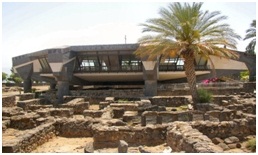
The church of Capernaum was founded on the traditional site of St. Peter's home.
Closer to the shore than the synagogue, the house was in a poor area where the drystone
basalt walls would have supported only a light roof (which suits the lowering of
the paralytic in Mk 2:1-12) and could have no windows. The floors of these houses
and courtyards were made of black basalt cobbles, in which it would have been easy
to lose a coin (Lk 15:8). By the mid-1st century AD, there is evidence that one
room in this complex was singled out for public use: pottery and lamps replace utensils
of normal family use, and there is ancient graffiti in the plastered walls, some
of which mention Jesus as Lord and Christ. The house was certainly a church by the
time Egeria made her pilgrimage in 381, which she said included the original walls:
"In Capernaum the house of the prince of the apostles has been made into a church,
with its original walls still standing."
Archaeological excavations indicate it was indeed around this time that the room
was given a more solid roof, which required the addition of a central arch, and
two rooms were added on the two sides. This was probably the work of Count Joseph
of Tiberias, a converted Jew, who obtained authority from Emperor Constantine to
erect churches in Capernaum and other towns of Galilee. In the 5th century, the
site was razed to the ground and a grander church was built in its place, indicating
increased Christian population and pilgrimage to Capernaum. The new church was octagonal
in shape and had an ambulatory; this layout is identical to churches of the same
type in Italy and Syria and similar to the Dome of the Rock in Jerusalem (built
later). The central octagon enshrined the venerated room from Peter's house, which
was given a floor mosaic featuring a peacock and a lotus-flower border. An apse
with a baptistery was soon added on the east end. In 570, the Piacenza pilgrim reported
that "the house of St. Peter is now a basilica."